What bushes to make a hedge. Periwinkle: photo of flowers, and how to care for the plant. Trimming and shaping
Back in the III century BC. the gardens of the Romans were decorated with "walls" of trimmed bushes. So for thousands of years there has been an ongoing selection of the best varieties and species of trees and shrubs that are suitable for the formation of hedges. With the help of properly selected plants, you can create real works of art from ordinary thickets. But the hedge performs not only a decorative function. For example, in medieval England, local landowners fenced their territories with trees and shrubs. At the same time, the fence not only served as a “living fence”, but also protected the site from the cold wind. Today, when there are so many various materials and technologies with which you can easily and quickly build a fence, there is still a tradition to equip hedge. Nothing can compare with it in decorativeness, attractiveness and functionality. When choosing plants for a hedge, you need to clearly understand what you want to see in front of you, what functions the hedge should perform and how much money and time you are willing to spend on its maintenance.
Butterfly wood and elderberry are easily recycled, making them invasive. And these are vigorous shrubs that will drown out others if you have the right idea to include them in your hedges. The gardener is by nature a patient. When choosing a fast-growing shrub, it often has a specific purpose: to insulate yourself! Don't look or see! calmness! and fast!
This last one is much appreciated because it quickly forms beautiful hedges, very dense, but it doesn't end there! Normal: A mature cedar is programmed for a height of 5 to 15 meters! Think about this when you decide to set up your hedge. Consider: How many times a year do you really want to prune your hedge?
How to choose plants for hedges - what you need to consider
Despite the abundance of information on plants and technologies for growing them, as soon as the decision to plant a hedge comes, many questions immediately arise: “What to plant?”, “How to plant a hedge that is ideal for a particular garden?”, “What types of plants to plant?” , “How many plants to plant?”, “How to plant?”, “How much will the hedge grow?” and many others.
When choosing shrubs, look at their size at maturity, this is a good indicator. Trick: Jules the gardener talks about the size of plants at maturity! If you're an impatient gardener, consider pending solutions. For example, you can double your young hedge with heather bristle or reed panels. These screens will protect your hedge as it grows, isolating you from view, and will be easy to remove when your hedge is taller.
Hedges usually serve to decorate or protect a particular outdoor area. The screening effect is usually obtained with high hedges, that is, at heights of at least two meters. Hedgehogs with regular growth plants can take months or even years to reach a happy two meters in height. In this case, it would be better to use fast growing hedging plants. These are species that, once established, grow rapidly, producing short, dense, thick hedges within a few months.
The selection criteria for hedge plants take into account several important points. To choose the right hedge crops, ask yourself a few questions:
- What functions should a fence perform?
- How tall should plants be for hedges?
- Should the hedge be clipped or free growing?
- How much free space can be allocated for a fence?
- What kind of plants should be in the hedge: thorny, weaving, flowering, fruiting, evergreen, or others?

Laurozeroza is stable and does not require excessive body care. It is a vigorous growing plant that requires two or more pruning courses throughout the year. Laurel grows rapidly, gives life to fat hedgehogs, but has the disadvantage that it is susceptible to parasites and diseases. A fast growing hedge that is very hard to find is the exotic muria, a small-leaved plant that produces fragrant flowers similar to orange blossoms. The exotic wall hangs and blooms even at low temperatures.
This hedge is not intrusive and gives a good covering effect and an excellent aesthetic result. Another fast growing hedge is based on ringospernum, a plant that produces fragrant flowers very similar to jasmine. For its growth, it must also be guided manually. However, with the right attention, the bright vibration grows very quickly. The only downside is that it tends to over-expand all available space. Other fast growing hedge plants are thorns, much like small pines.
- Should the fence be single-tiered or multi-tiered?
- Should the fence be solid or variegated, combining different colors or shades of the same color?
- How long are you willing to wait until the fence grows to the required size? Maybe you need fast growing plants or just mature seedlings.
The answers to these questions will only be "tracing paper", according to which you can make a choice among the variety of options. But that's not all.
These plants are not very popular due to their high cost. Alternatively, you can use a ligusto, a fast growing hedge plant suitable for any type of soil and very easy to care for or prune. A hedge hedge grows quickly and lends itself to some sort of pruning to take up the height and desired position. Most of the shrubs used to make hedges have a fairly fast development because often a small and compact screen is preferred over several years rather than waiting for a long time for the branches of various plants to intertwine to form a single barrier. Generally, fast growing hedge plants also have a lower price because the cost of a nursery plant is highly dependent on the time it takes to sow from sowing to sale.
The most important thing to start from is the initial conditions:
- What type of soil do you have on the site?
- How close is moisture?
- How often does it rain?
- Sunny area or shaded?
- Do you have a site near a reservoir, on a plain or on a hill?
- Is there strong wind in the region?
It is the answers to these questions that will put everything in its place. For example, if you have a swampy area on your site, which is flooded with water every year in the spring, then growing a pine or apricot as a hedge, a pear simply will not work. Their root system will rot. Plants must be selected to suit the conditions of the site.
Therefore, the majority fast growing plants hedges are the ones we are used to seeing in Italian gardens. A fast growing bush allows us to have a hedge ready in no time; or allows us to enjoy another advantage: even if we plant small bushes, due to the young age, our hedge will be ready in a few years with significant savings.
There are several types of plants and shrubs for fast-growing hedges: we can use plants that would be large in nature, exceeding 6-8 m in height, such as cypresses or antlers; or we can choose climbers who will develop very lasting effects every year; or yet, there are many shrubs that, if planted individually, can reach a height of 3-4 meters in a few years. Obviously, in addition to advantages, there are also disadvantages: for example, hedgehog trees, they grow quickly, but also tend to develop very large, until they take up many meters of land and therefore cannot be used in small gardens.
Let's start with the first question.
Hedge Functions:
- Close the area from prying eyes, and maybe paws.
- Fence off the area so that no person or dog can get through.
- Disguise the fence garden building, shed.
- Create a barrier from the side of the road from noise, gases and dust.
- Create a backdrop for a garden or just a decorative composition.
- Antiseptic function - protection against pathogenic bacteria.
- Holds snow in the area.
- It can produce fruits or berries.
- May be an evergreen wall.
- It can zone the site, separate the garden from the playground, or focus on the garden path if the border fence is planted along it.
- Hold back the wind.
The height of a hedge is inextricably linked to the functions it can perform. For example, decorative fencing of flower beds and paths can be organized using plants up to 50 - 70 cm high. And only a high dense fence can protect the site from prying eyes, trap the wind, protect against noise, gases and dust - from 3 m or more high. Also, sometimes a low hedge 1 - 2 m high is enough to divide the site into zones, to separate it from the neighboring site, or to slightly enliven the view of an existing fence. Climbing plants should be singled out as a separate category, since their development requires support, for example, a chain-link fence, wooden fence from shtaketin, a stone wall of a house or others.
Fast-growing and fast-growing shrubs, however, are very vigorous, but this means a lot of pruning operation after the hedge is the desired size. To create a hedge over several years, it is convenient to choose shrubs that have a rapid development, but do not tend to grow like trees, or occupy the entire garden. Most fast-growing hedge plants do not usually exceed 3-4 meters in height for many years, but in order to contain its abundance, it will still be necessary to intervene at least twice a year with pruning to bring the hedges to their ideal shape. .
The height of the hedge is divided into several categories:
- Very high - more than 3 m.
- High 2.5 - 3 m.
- Medium 1.2 - 2 m.
- Below human height - 1 - 1.2 m.
- Border - 50 - 70 cm.
All of the above types of hedges can be organized with the help of various plants, some of them easily tolerate a haircut, while others can only grow freely.
The same can be said for some plants, such as wisteria or passionflower, which can destroy supporting structures or become weaker plants. We always keep in mind the concept that the hedge must first be balanced and vigorous, with plants that have a balanced development: in some cypress gardens of 6-7 square feet, other crops will suffice and they will not fit at all. Such a structure can be a hedging. It can be made from various plants - broad-leaved and coniferous.

Sheared or molded hedge differs in that the plants in it are planted very densely, almost merging into a single whole. The crown of trees and shrubs is constantly trimmed, forming rectangular or rounded shapes. It is, of course, beautiful, and many people like it very much because the molded fence takes up less space.
Anyone, even if there is no concept of gardening, can grow a magnificent and dense hedge, if he adheres to a few simple and simple rules. If, however, they are on a bare root, which is much cheaper, they are sown in the spring before vegetation occurs. Plants are planted on push-pull schemes, 5-10 per linear meter. Plants are placed in it and buried when the soil around the roots is carefully removed and watered abundantly. Frequent pruning of the hedge, especially during the summer months, is a must for it to be nice and dense.
But there are several disadvantages of such a fence:
- A molded hedge is unable to bloom, as most of the young shoots are cut off during molding.
- Such a fence is not able to bear fruit.
- For the same reason, plants in clipped hedges require constant feeding, as most of the branches that capture sunlight are cut off.
- And finally, you need to trim at least 2 times a year. This requires knowledge, skills and dexterity. The cost of such work is not cheap.
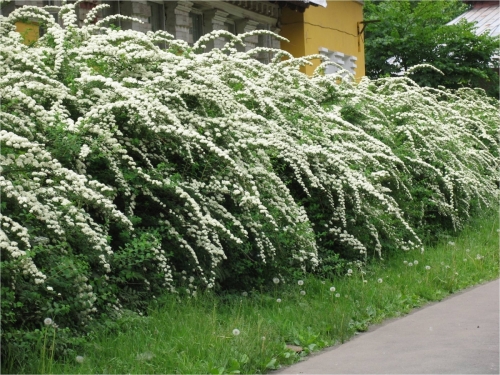
The pruning speed depends on the growth rate of the hedge. It is important not to forget that the more often it is cut off, the thicker it will be over time. This is especially important for getting off at the beginning. Here, of course, we are talking not only about "Bird Grapes", but also about plants in general. They can be different types: Spiraea, Lonikara, Hennomeles, Pirkantana, Lavrovina, Chashkadry, Chemshyr and many others. When choosing aircraft, we must not forget that the ligator is impressive only from spring to autumn - in winter the leaves fall.
If we are looking for a year-round effect of the desired hedging, we must choose coniferous plants. Very beautiful, for example, although much more expensive, is the hedge of this. He lays 2-3 plants per linear meter. When planting, it is important to bind the soil tightly around the root ball and not to accumulate soil above its level.
free growing or unshaped hedge takes up more space, as the plant scatters branches to the length required for its development. But it can bloom and bear fruit. Usually, flowering ornamental shrubs or fruit-bearing bushes, such as currant or dogwood, are used to create an unformed hedge.
Then it needs to be poured with plenty of water to cover the soil. When we regularly take care of plants, they become more beautiful and easier to maintain. This does not happen instantly, but only after a year or two passers-by will delay their step, looking at our "live" fence. Then, of course, you rush to the green fence, you want to grow as fast as possible and look beautiful for years. Luckily, there are plants that offer you all of these qualities. For cultivation purposes, they have been adapted from the original species for such purposes.
It is also not necessary that plants of only one height be present in the hedge. Often they create a multi-tiered hedge, in which plants of different heights create an organic composition and a blank barrier, including below in the near-trunk space. Plants in a multi-tiered hedge do not interfere with each other, as their crown easily captures the sun's rays, and the roots are at different depths and do not compete for nutrients.
Of the different types of shrubs, we have two of you that are less common, but they do well in our country, and your garden will give you an extra touch of originality. For cottages and cottages where you spend most of your time in the summer, you don't mind having the hedgerow fall for the winter, but you'll need to be thick and green throughout the year.
The deciduous fence of the Siberian ice elm with a special cracked bark has always been part of the natural forest vegetation in our country, and later became an adornment of castle gardens and city parks. However, at the beginning of the century, the epidemic of the fungal disease of graphosis was gradually eradicated. There were more resistant varieties, real deer elm, but in the end nature herself. There is another fungus that destroys graphics. Species that we consider ideal for planting fast growing hedges are also very resistant to graffiti.
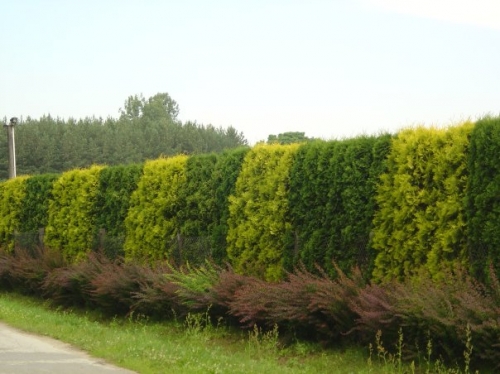
For a multi-tiered hedge, plants are selected in such a way that they do not obscure each other, match in color, and also bloom not at the same time, but in turn.
Let's take a closer look at which plants the hedge will be most suitable for your garden or plot. Let's divide the plants by height, because earlier you have already decided what size you want a fence.
This is Siberian Elm, also known as Turkestan Brest. The ideal time for planting is now in October and early November, the seedlings are cut to a height of about 30 cm, and in winter they will be well rooted and grow quickly. Annual increments of height and width are more than a meter. In two years, you will have a thick two-meter fence that can be very well formed, does not need special soil conditions and grows equally well in warm rooms such as cold foothills. For a future wide and dense fence, it is best to put the elm in two rows at a distance of about 30 cm, and also plant individual plants about 30 cm apart.
Plants for high hedges - above 3 m
Plants over 3 m tall are usually used for tiered hedges, forming the highest tier, or when plants are planted near a fence in a single tier. Considering that tall plants have a deep developed root system, be sure to consider all the nuances of your site.
Interestingly, it can also look like an unclaimed fence of salty greens that you can only adjust for height. Even if you need a long fence, you don't have to worry about financial requirements, salads High Quality, which you get in the gardens up to 30 crowns apiece. Siberian Hedge Knit has a lifespan of up to sixty years, while maintaining the density of the lower branches, leaving it beautifully green from spring to autumn.
Although this woody-stalked grasshopper does not appear to have better conditions in our country, there are more than thirty species that work well with us and do not require any special care. Many species are deciduous and used primarily as piper sticks, such as the multicolored red or yellow woody stems. Its thin dense yellow-green stems grow up to three to five meters in height, they can be cut well, and the brush becomes lush and wide. You can also plan for a warm fall, but if it's already freezing, put it in for spring.
For loamy soils:
- Yew berry (pictured below).
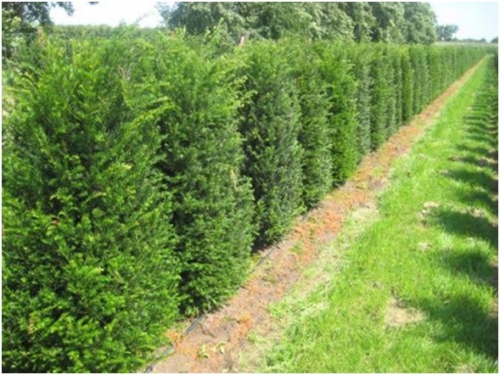
- Linden.
- Elms.
For wet sandy soils:
- Bird cherry antipka.
- Juniper Cossack.
- Apple trees.
- Common bird cherry (pictured below).
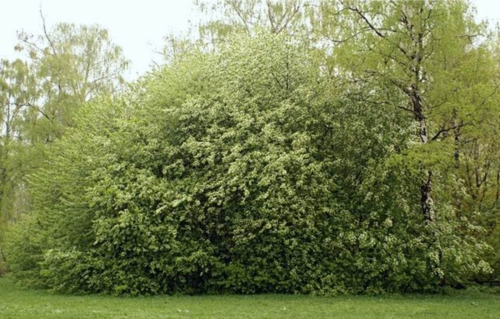
For dry sandy soils:
- Common pine.
For wet neutral soils:
- Kalina Canadian.
- Kalina Bureinskaya.
- Apple trees.
- Thuja western (pictured below).
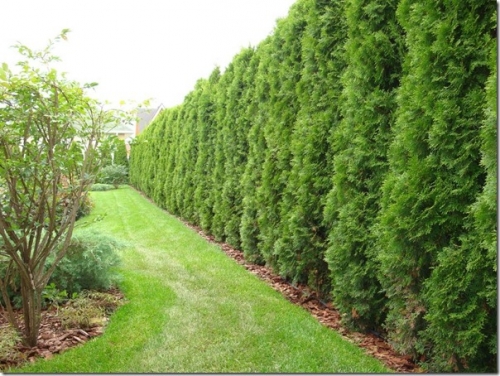
- Korean pine.
- Willow goat.
- Manchurian apricot.
- White willow (pictured below).
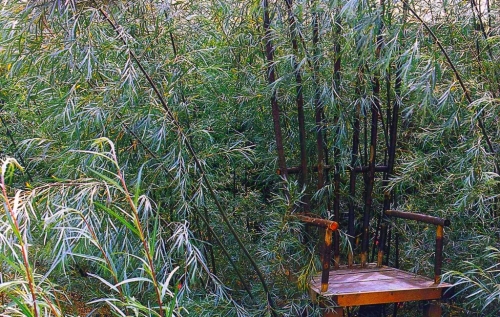
- Bird cherry Pennsylvania.
- Spruce ordinary.
- Pear loholistny.
- Spruce is prickly.
- Ash willow.
- Siberian spruce.
- Korean spruce.
- Mountain pine.
- Poplar.
Also for a high hedge, you can use the following plants:
- Ash.
- Buckthorn laxative (pictured below).
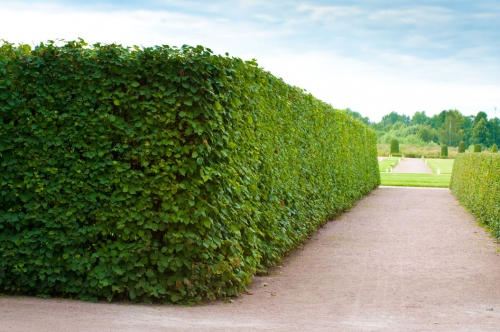
- Norway maple.
- Willow basket.
- Ussuri pear.
- Mountain ash.
- Honeysuckle is golden.
- Siberian hawthorn.
- Maple Tatar.
One of the main functions of a high hedge is wind protection. A high solid wall, planted in two rows, is able to hide the site from prying eyes and significantly reduce wind speed.
Hedge plants 2.5 - 3 m high
Fences with a height of 2.5 - 3 m are also classified as high. But the plants in it do not exceed 3 meters in height, i.e. are not higher than the highest fence and do not hide the house. They can also be used for fencing or for zoning a site, but they are not able to hold back gusts of wind.
For loamy soils:
- High grades of mock oranges.
- Lilac Zvyagintsev (pictured below).

For wet sandy soils:
- All lilacs.
- Common juniper ("Hibernica" and "Meyer").
- Forest apple tree.
- Siberian apple tree.
- Japanese apple tree (pictured below).

- Manchurian apple tree.
- Nedzvetsky's apple tree.
- Irga is smooth.
For dry sandy soils:
- Siberian apricot (pictured below).
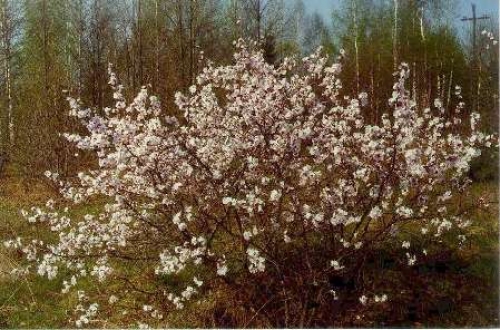
- Irga oval.
- Common pine.
For wet neutral soils:
- Lilac ordinary.
- Lilac Hungarian.
- Bird cherry virgin.
- Amur lilac.
- Chubushniki.
- Viburnum ordinary (pictured below).
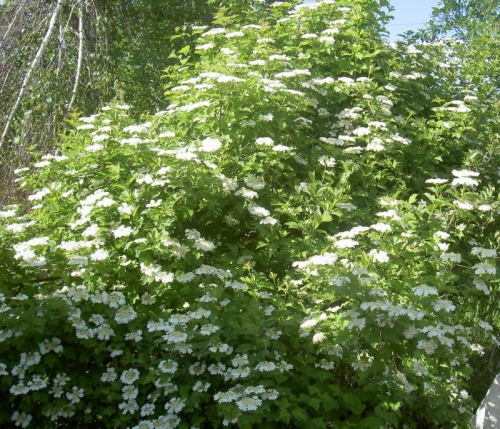
- Honeysuckle Tatar.
- Viburnum three-blade.
- Kalina Sargent.
- Lilac Wolf.
- Canadian Irga (pictured below).
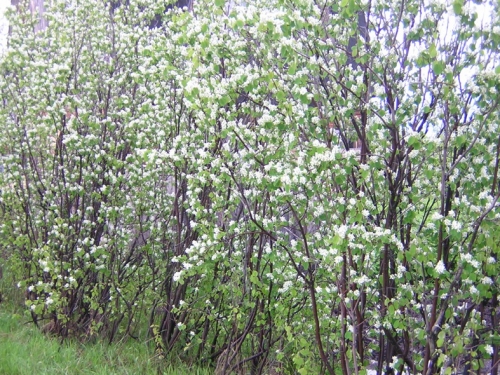
- Honeysuckle is common.
- Honeysuckle is blue.
Plants undemanding to soils:
- Amur lilac.
- Bird cherry Pennsylvania.
- Manchurian apricot.
- Lilac ordinary.
- Fieldfare rowanberry.
- Spirea Douglas.
- Spirea Billard.
- Honeysuckle Korolkov.
- Elderberry common.
- Lilac Hungarian.
- Canadian elderberry (pictured below).
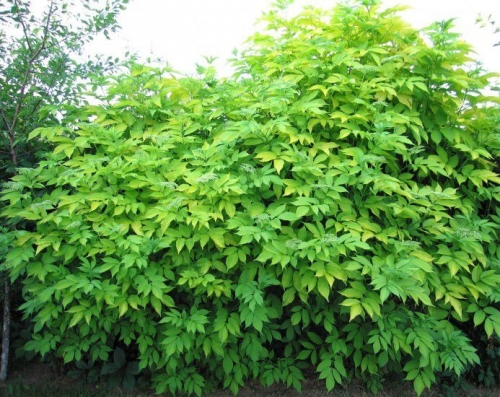
- Hydrangea paniculata.
- Derain is white.
- Deren is blood red.
- Spruce ordinary.
- Vesicle viburnum.
- Whole-leaved willow.
- Purple willow.
- Willow is the most beautiful.
- Mountain pine.
- Barberry common.
- Caragana tree.
- Sea buckthorn.
- Barberry Amur.
- Loch narrow-leaved.
- Aronia chokeberry (pictured below).

- Irga is spiked.
- Ginnal maple.
- Common hazel.
- Loch silver (pictured below).
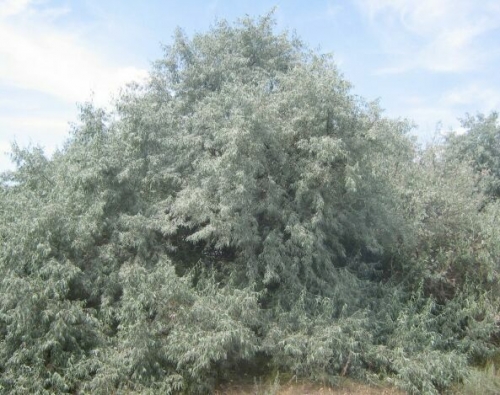
- Irga is smooth.
- Cherry ordinary.
- Felt cherry.
- Maple Tatar.
Between tall plants in a row of plantings, it is necessary to make a distance of 0.5 - 1 m. It is advisable to plant trees in two rows, making the distance between rows 0.5 - 0.7 m. Some shrubs, such as lilacs, abundantly form young shoots, thereby firmly hiding the entire space from top to bottom. If you plan to remove low shoots, then in the lower tier it is advisable to plant something low-growing to hide the gap.
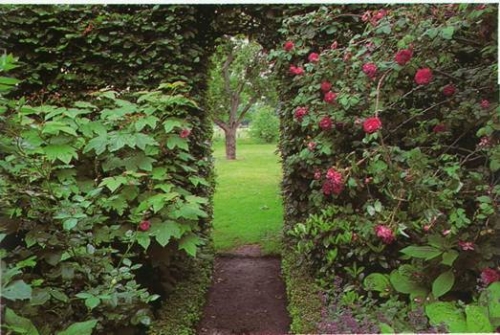
Climbing plants are mainly used to form a hedge on top of a mesh fence or just a solid fence. They can also be used to shelter a stone house or other buildings. Unfortunately, without support, climbing plants will not be able to form a hedge, so this option is not suitable for everyone.
Conditionally climbing hedge plants can be divided into two categories: annuals or those that have to be removed from the trellis before frosts, and perennials that are not afraid of frost and hibernate on trellises.
Plants for the season:
- Ipomoea (pictured below).
- Hop.
- Climbing roses.
- Clematis.
- Varietal grapes.
- Nasturtium.
- Sweet peas (pictured below).
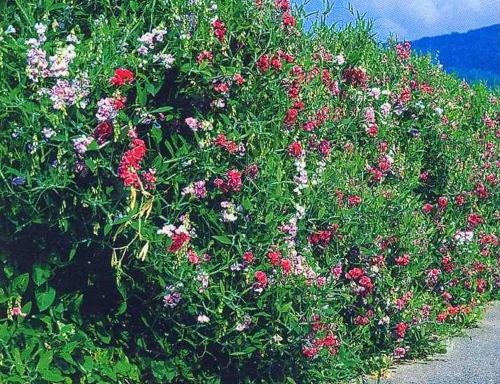
- Beans.
Frost-resistant perennial climbing plants:
- Girlish grapes (pictured below).

- The tree plier is round-leaved.
- Honeysuckle (various types).
- Hydrangea petiolate (pictured below).
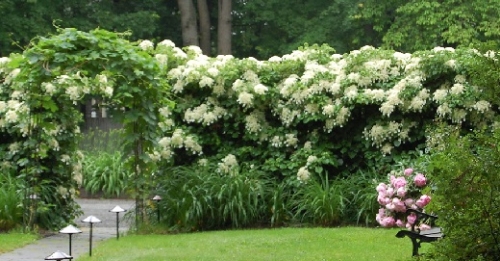
- Princes.
- Actinidia kolomikta.
- Alpine clematis.
All climbing plants can be classified as fast-growing, as they gain green mass, if not in one season, then in 2-3 years they completely form a continuous barrier of the required height.
Plants for medium hedge 1.2 - 2 m
Plants up to 2 m high can zone a plot or hide an unsightly extension. You can also cover garden fruit trees from winds and frost. You can buy plants for hedges in specialized nurseries. In this case, it is desirable to take plants with a closed root system, although they are more expensive.
For loamy soils:
- Chubushnik (medium-sized varieties) (pictured below).
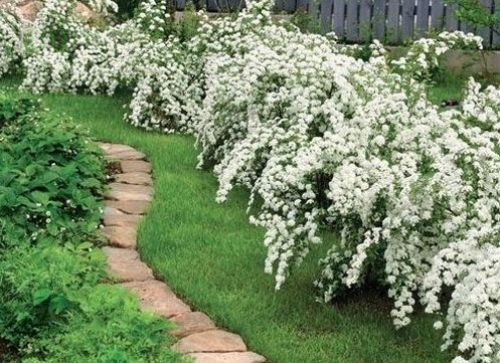
- Hortense Bretschneider.
For wet sandy soils:
- Common juniper (pictured below).
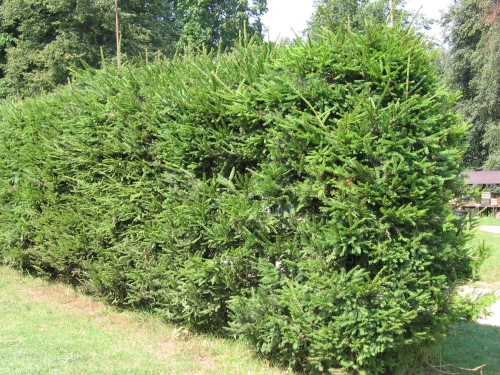
- Spirea gray (pictured below).

- Irga alder-leaved.
- Lilac ordinary.
For dry sandy soils:
- Irga round-leaved.
- Russian broom (pictured below).
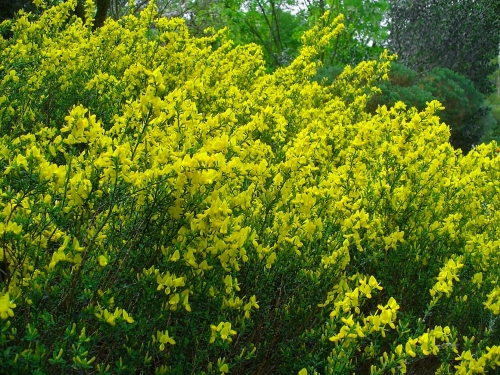
- Irga is profusely flowering.
- Common pine.
- Irga oval.
For wet neutral soils:
- Chubushnik ordinary.
- Chubushnik thin-leaved.
- Lilac ordinary.
- Honeysuckle is common.
- Honeysuckle is blue.
- Weigel Middendorf.
- Weigela early (pictured below).
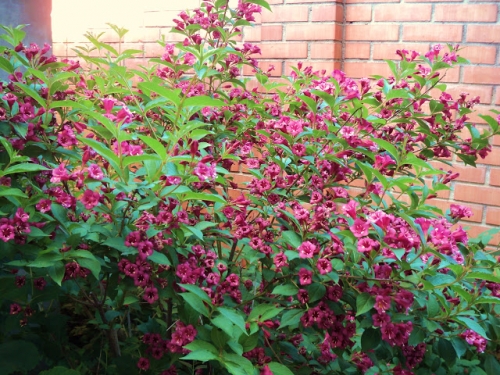
Plants undemanding to soils:
- Lilac ordinary.
- Weigel Middendorf.
- Barberry common.
- Spirea oak-leaved.
- Spirea medium.
- Spirea multiflora.
- Spirea Douglas.
- Mountain pine.
- Spirea willow.
- Spirea Bijer.
- Honeysuckle Korolkov.
- Raspberry is fragrant.
- Vesicle.
- Ottawa barberry.
You can also use these plants:
- Cotoneaster shining.
- Dog rose.
- Rose wrinkled (pictured below).
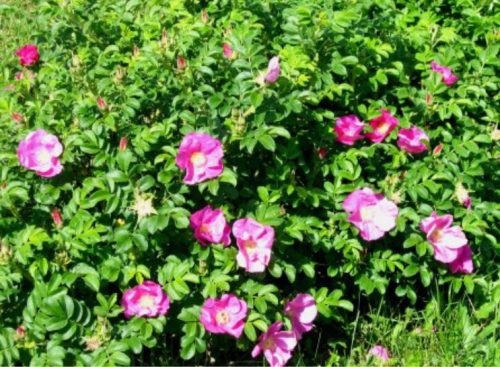
- Gray rose.
- Spirea willow.
- Currant is golden.
- Spirea gray sharp-toothed.
- Spiraea Van Guta (pictured below).
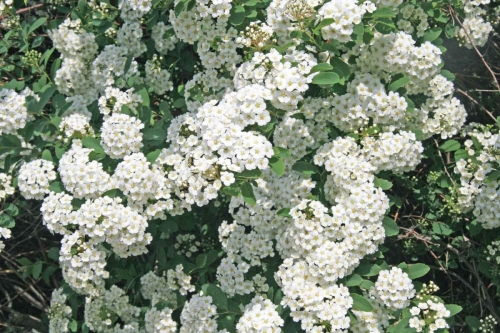
- Honeysuckle is covering.
- Alpine honeysuckle.
- Karagan shrub.
- White snowberry (shade-tolerant plant) (pictured below).
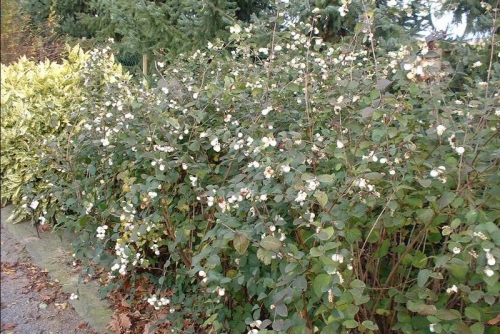
- Gooseberry.
- Alpine currant.
Many of the shrubs listed above give an excellent harvest of berries, they are often used in the country and in villages to separate neighboring plots, since according to the law it is impossible to equip a blank fence in such cases.
Hedge plants 1 - 1.2 m high
Low-growing shrubs are used to delimit the territory of the site and for decorative purposes. They cannot hide practically anything, since they do not exceed 1.2 m.
For loamy soils:
- Chubushnik "Snow Avalanche".
- Irga is low.
- Mock orange "Moonlight" (pictured below).
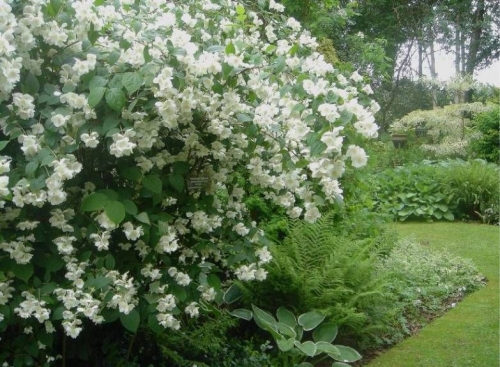
For wet sandy soils:
- Japanese quince (pictured below).
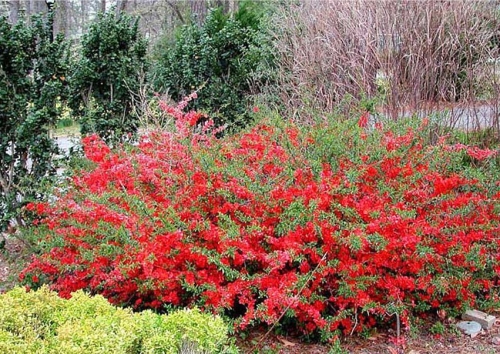
- Irga alder-leaved.
- Iva is beautiful.
For dry sandy soils:
- Forsythia ovoid (pictured below).

- Irga is low.
- Cherry sandy.
- Drok dyeing.
- Gray cherry.
- Gorse radiant (pictured below).
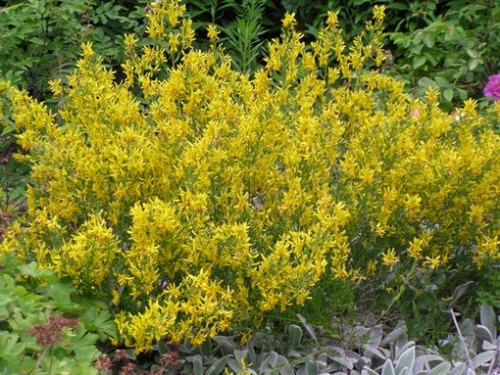
- Common pine.
- Broom blackening.
- The broom is oblong.
- Zinger's broom.
For wet neutral soils:
- Small-leaved mock orange (pictured below).
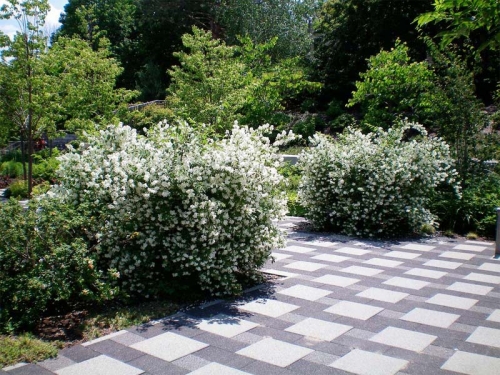
- Irga alder-leaved.
- Chubushnik ordinary.
Plants undemanding to soils:
- Spirea crenate.
- Vesicle.
- Kuril shrub tea.
- Japanese spirea.
- Maoina is fragrant.
- Spirea lilac.
- Cedar elfin.
- Spiraea Bumalda (pictured below).

- Mountain pine.
You can also use other plants:
- The cinquefoil is shrubby.
- Karagan orange.
- Karagan shrub.
- Ferrous cherry.
- Cherry Bessey.
- Steppe almond.
- Chubushnik "Chamomile".
- Chubushnik "Pompon".
- Chubushnik "Aureya".
- Boxwood (pictured below).
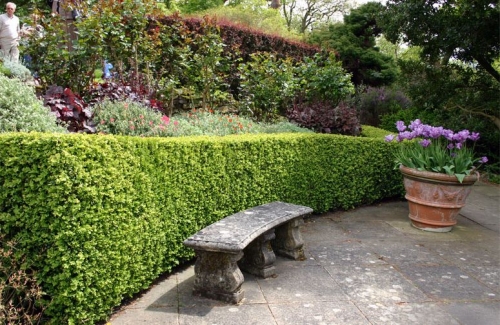
All spireas, mock oranges and lilacs bloom beautifully, creating a unique magical atmosphere in the garden.
Plants for border hedges - up to 50 - 70 cm
The very name "borders" already speaks for itself. This category includes undersized plants, barely reaching the knee of a person and sometimes to the waist. They are used to fence flower beds, paths, ponds and to form a decorative component of the garden.
For loamy soils:
- Chubushnik "Gnome" (pictured below).

- Chubushnik "Dwarf".
For wet sandy soils:
- Japanese yava.
- Heather ordinary (pictured below).
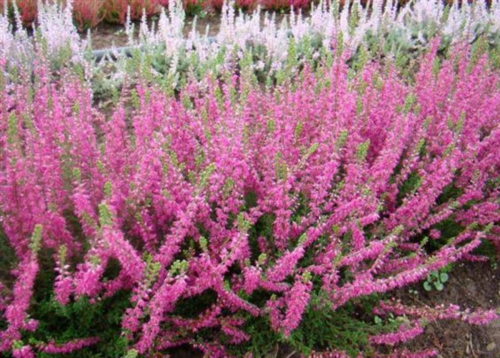
- Iva is beautiful.
- Cowberry.
For dry sandy soils:
- Steppe almond.
- Willow alpine.
- Steppe cherry (pictured below).

- Cherry sandy.
- Cherry Bessey.
- Karagany.
For wet neutral soils:
- Cherry sandy.
- Ferrous cherry.
- Chubushnik "Dwarf".
- Mahonia holly (shade-tolerant plant) (pictured below).
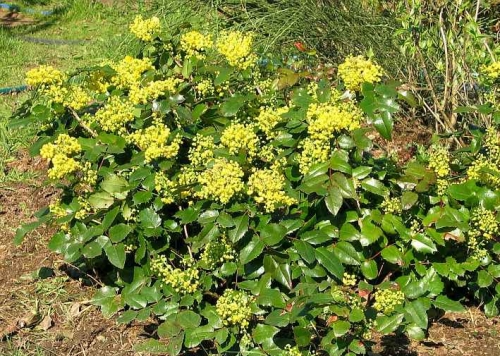
Plants undemanding to soils:
- Meadowsweet birch.
- Kuril Dahurian tea.
- Broom purple.
- Barberry Thunberg.
- Meadowsweet Bover (pictured below).

- Mountain pine.
Fast growing hedge plants
Most trees and shrubs for hedges take a long time to grow and form a crown. Yew, for example, will reach the required height only in 20 - 30 years. It can be planted for grandchildren. But the cypress tree can be safely planted for yourself. With an increase of 90 cm per year, in 5-6 years it will reach a height of 3.5 m.
Those who want to grow a hedge as quickly as possible should turn their attention to plants that develop quickly.
First of all, these are climbing annuals: morning glory, clematis, beans, nasturtium the fence will be braided by mid-June - early July. But in autumn and winter, your fence will be bare.
And you grow very quickly, especially in moist soils. Although they are not demanding on moisture and soil composition, they develop more readily in wet areas. They also reproduce extremely simply - just poke a twig into the ground and water it in time.

It can also be attributed to fast-growing shrubs, which also produce beautiful berries.
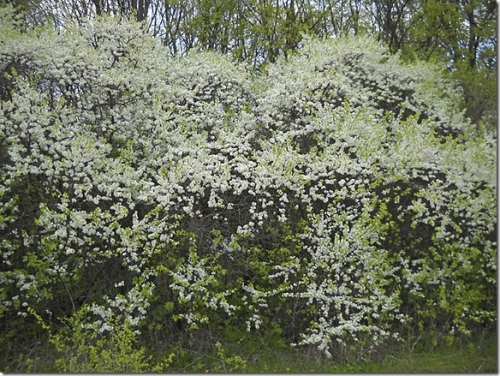
can form an almost impassable hedge, undemanding and hardy. The fruits can be used as food for making sauces and jams.
rose hips and tea rose grow very fast. In addition, they are prickly, a hedge formed from wild rose - an insurmountable obstacle.
Other fast growing shrubs:
- Black chokeberry.
- Felt cherry.
- Hawthorn.
- Dogwood.
- Vesicle viburnum.
Most trees and shrubs love the sun, so they require well-lit areas. But one can distinguish shade tolerant plants, which are planted in a deep shade: Siberian cedar, Norway maple, field maple, small-leaved linden, yew, crab, fir, spruce, boxwood, viburnum, laurel cherry, heather, svidina, periwinkle.
Plants that can be planted near water bodies: willow, hydrangea, gorse, rakita, viburnum, euonymus, sea buckthorn, spirea, fuchsia, yucca, rosemary.
On very heavy soils, the following plants take root easily: barberry, deren, cotoneaster, hawthorn, hazel, mock orange, spirea, weigela, Japanese quince, snowberry, decorative viburnum.
In conclusion, I would like to say, no matter how much you would like to quickly create a high hedge, you still should not buy seedlings higher than 1 m if you live in an unfavorable gassed region or where strong winds blow. Tall seedlings are much harder to take root and adapt, the loss of planting material is inevitable.
The fencing of private properties from a profile sheet, wood or brick has become so familiar that few people pay attention to them. Do you want uniqueness, beauty and an interesting design solution that stands out from the crowd? Evergreen perennial fast growing hedge - perfect solution for fencing the site, which will not only perform protective functions, but also delight the eye with its beauty and shape. The choice of plants is quite extensive, and each option has its own nuances in planting and care.
Perennial evergreen fast growing hedge: how to choose the right option
Perennial evergreen fast growing hedge is often used in landscape design. It can play the role of a separator within the site, be a frame for paths or surround various objects, and also complement the architectural complex of buildings. And also act as a direct frame for everything suburban area or a private house.
Working with living plants provides ample opportunities for creativity. You can choose a compact, dense high or low hedge. And choosing the option with thorns, in addition to beauty, you will get natural protection against foreign penetration.
Advice! The height of the hedge is different, but the width is traditionally no more than 80 cm. This point should be taken into account when choosing such a decorative element.
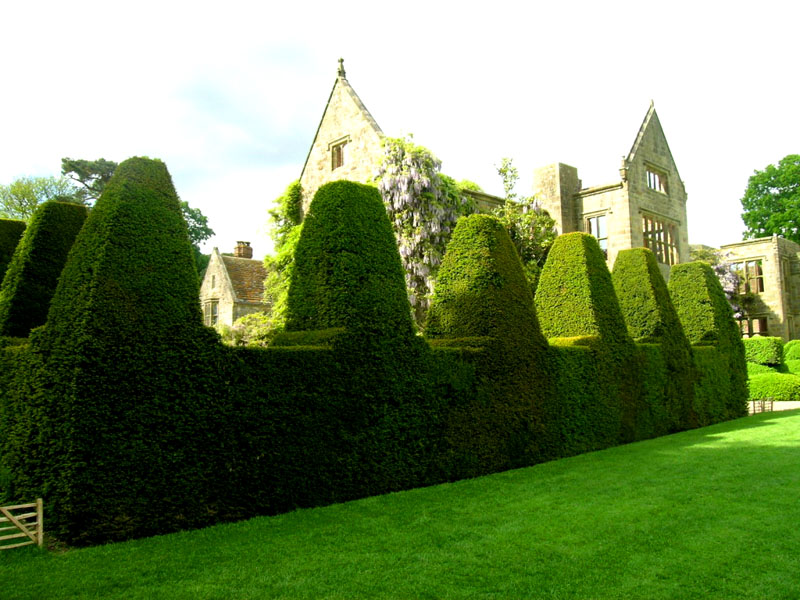
There are a number of requirements that are put forward for plants used as a living fence:
- With a large length of the hedge, it is worth choosing unpretentious plants. If you choose a shrub that requires careful care, then, processing hundreds of bushes, any desire to take care of such decor will disappear.
- In conditions middle lane pay attention only to frost-resistant plants. Otherwise, you will have to plant new plants every spring, which is expensive and inconvenient.
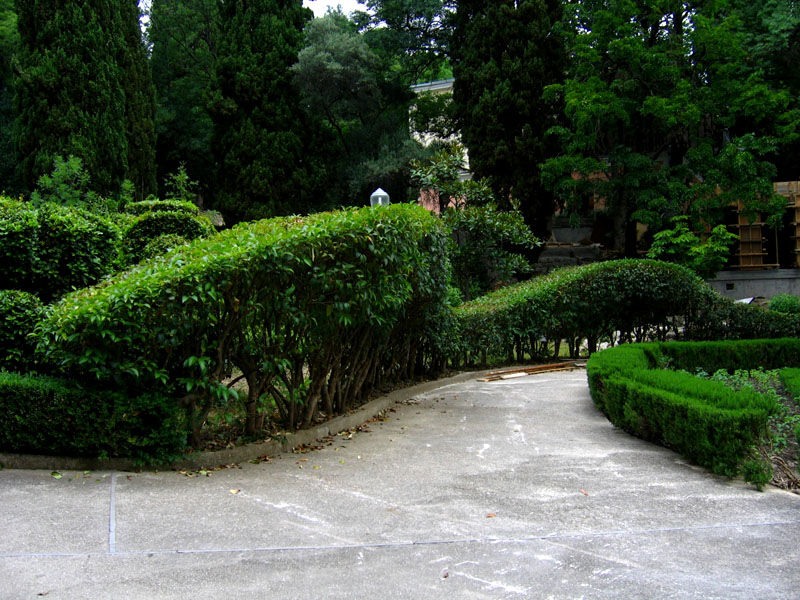
And also when choosing a live fence, pay attention to the following factors:
- how fast the shrub grows and develops;
- are there fruits and flowers;
- is it possible to cut and shape the bushes;
- how long does the decorative season last;
- no strong growth.
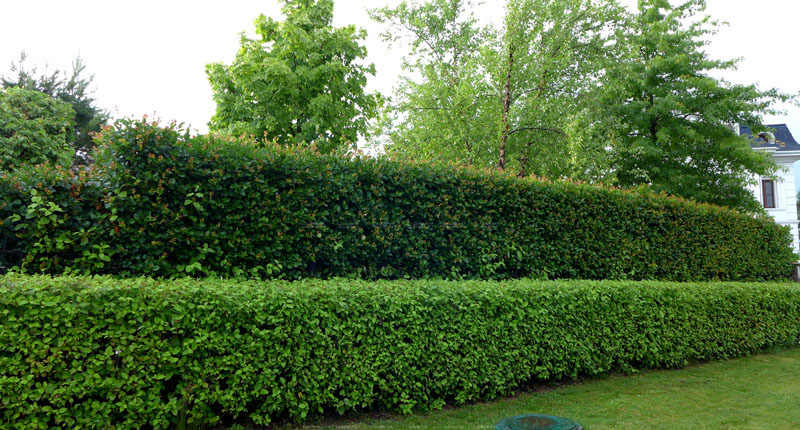
There is a special type of plant -. For them, you will need to make a fence or install trellises. This type of landscaping is located around the perimeter of the site, forming cascades of greenery.
Do-it-yourself hedge in the country: which plants are suitable
Based on the selection parameters, summer residents or owners of private buildings can choose a hedge from a wide range of plants. Among the suitable ones there are deciduous ones with beautiful inflorescences, coniferous ones with lush paws and curly ones that create a unique silhouette.
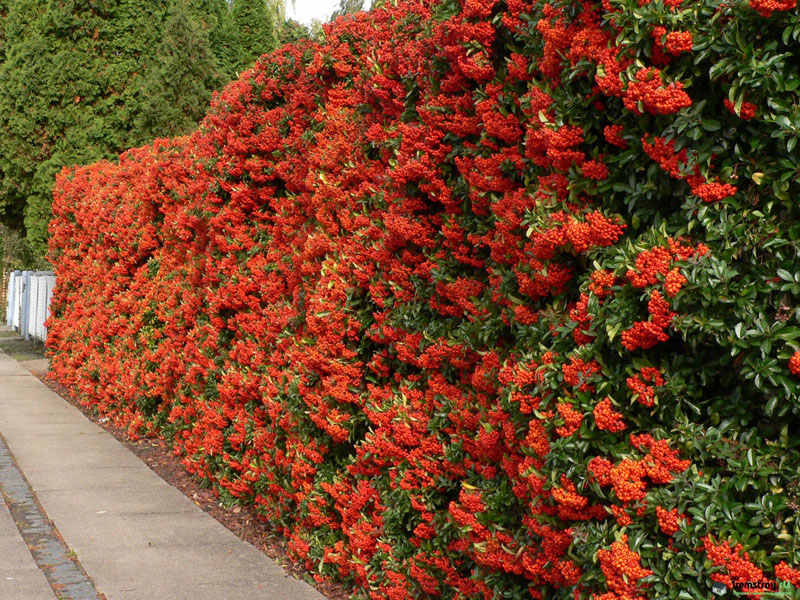
You can independently grow the following types of shrubs:
- barberry;
- periwinkle;
- euonymus;
- privet;
- hawthorn;
- honeysuckle;
- kampsis;
- cotoneaster;
- cypress lawson columnaris;
- Cupressocyaparis Leylanda;
- laurel cherry;
- holly;
- fir;
- ivy;
- boxwood;
- thuja Brabant.
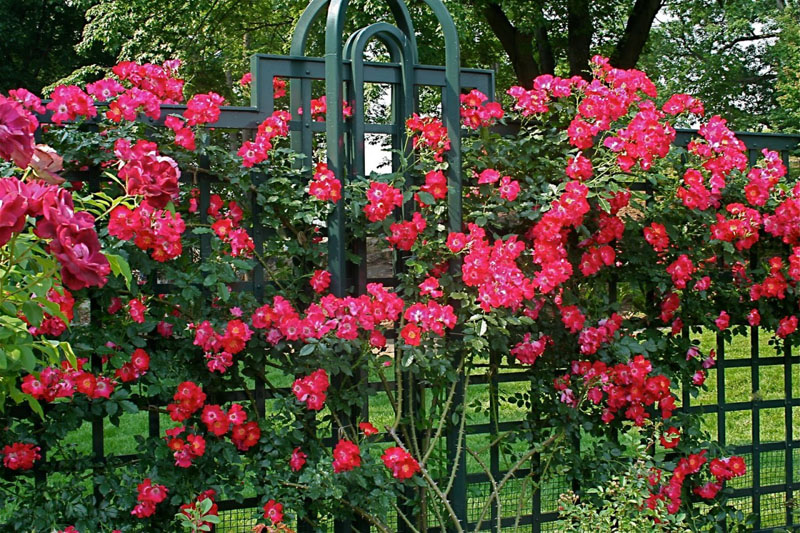
All these plants are able to create a dense crown to close your site from prying eyes or divide a large area into recreation areas. We will analyze in more detail the landing and care of each type, so that it is easier to make a choice.
Related article:
Photos and other materials from this article will simplify the adoption right decisions. They will help to accurately implement the most daring ideas, eliminate errors and not exceed the established budget.
Photos and names of fast-growing plants for hedges
First, let's look at what each of these plants looks like. After all appearance plays a huge role in creating landscape design.
- Barberry- plastic plant. From it you can form or high fences. Suitable for cutting, so you can give the bush any shape.
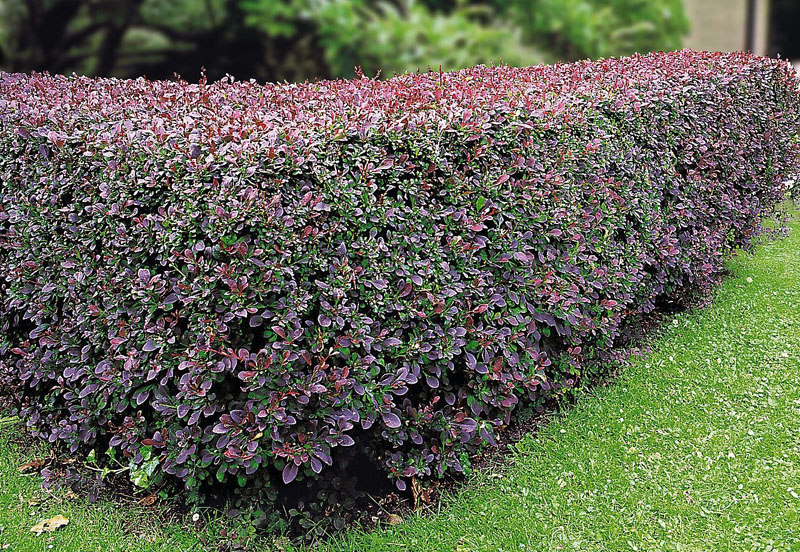
- periwinkle- an evergreen climbing subshrub. It reaches a height of 1.5 m. The stems and leaves are distinguished by their endurance and retain their beautiful appearance for a long time. The flowers are large, blue or blue.
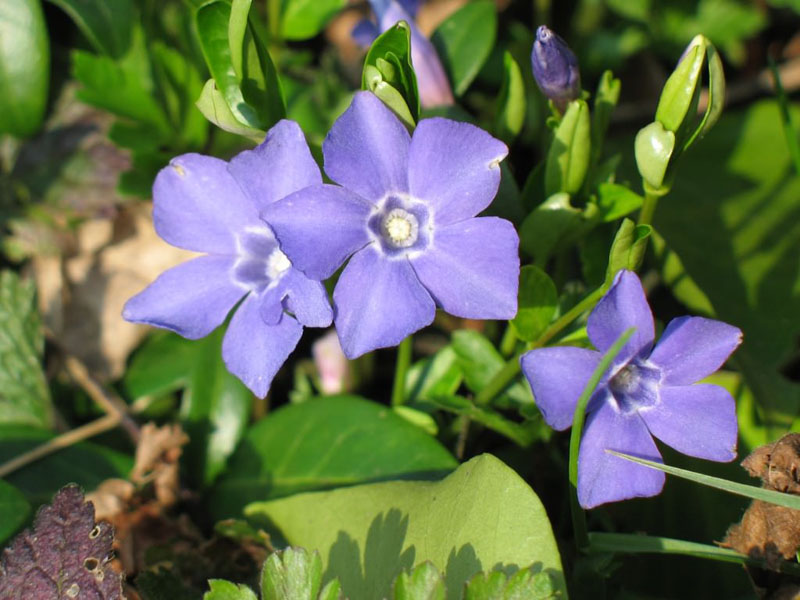
- Euonymus- has many varieties, including a curly version. Particularly popular are Fortune, Blondie or Sunspot, which have decorative foliage colors.
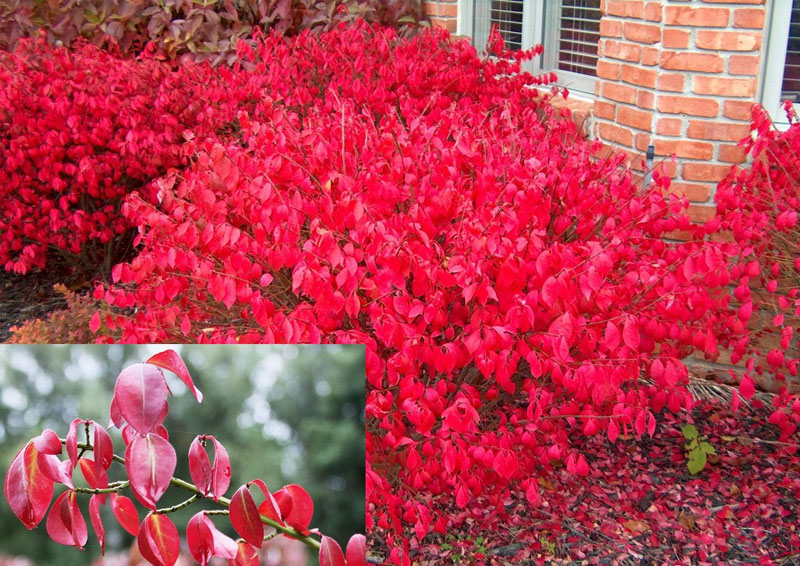
- Privet- A fast growing shrub. Blooms in early summer, but not for a long period. Suitable for southern regions: does not tolerate frost. In height more than 2 m does not happen.
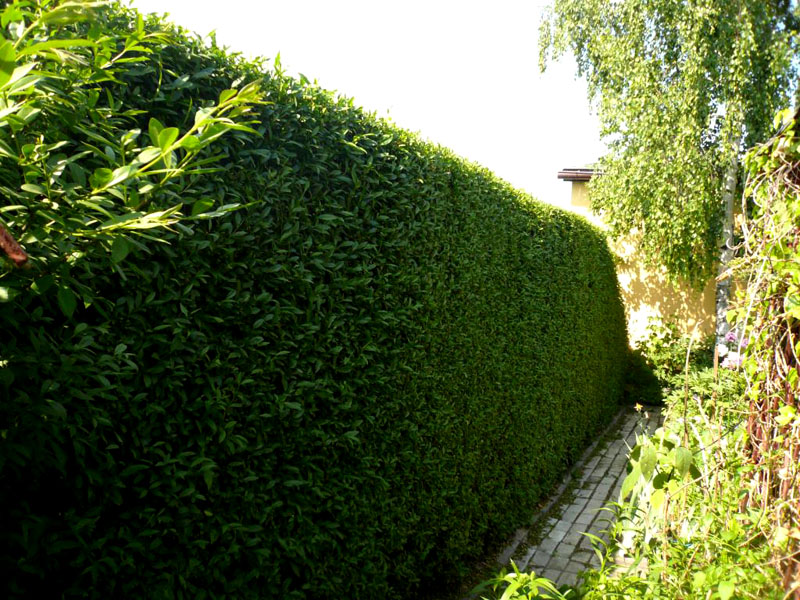
- Hawthorn- shrubs are often used as a hedge. In addition to the protective properties, the plant has edible fruits that are medicinal for the cardiovascular system.
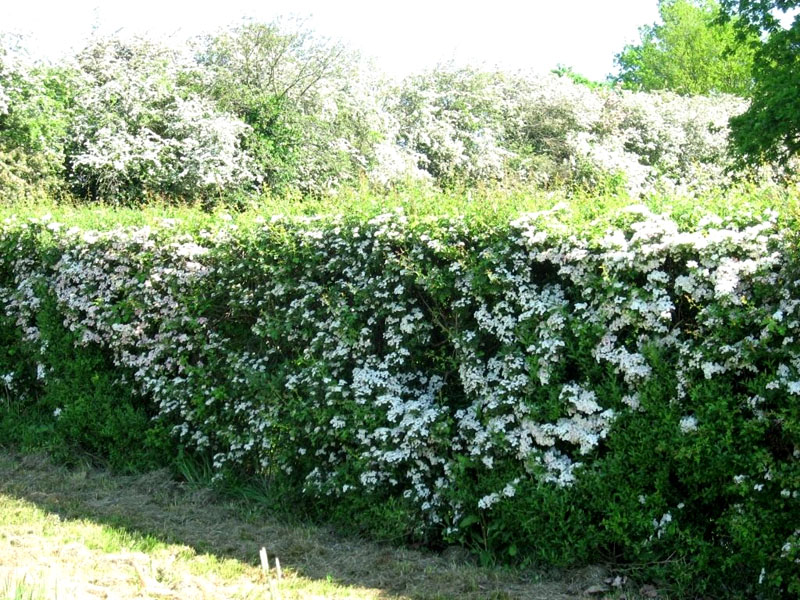
- Spruce- coniferous tree, which is often used for decoration. It is unpretentious, easy to care for and resistant to any frost.
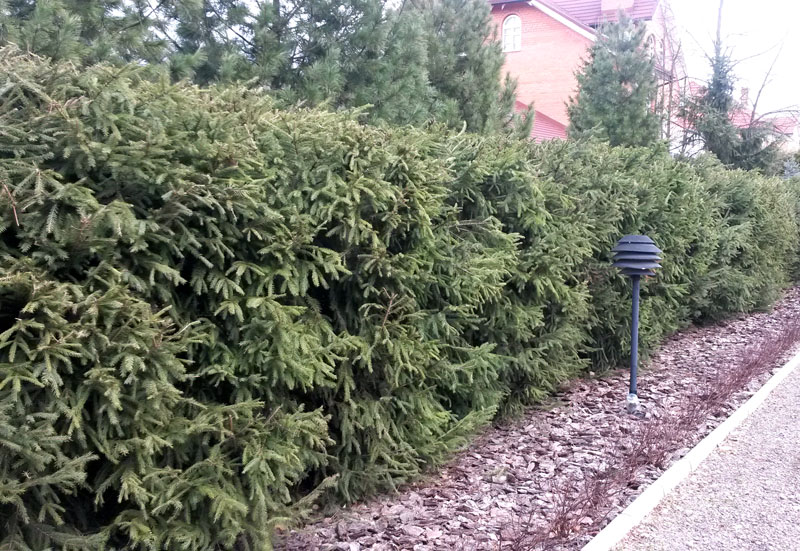
- Honeysuckle- has many varieties, is not demanding on the soil, and it is better to place the plant in partial shade. Resistant to frost, which is important in central Russia.
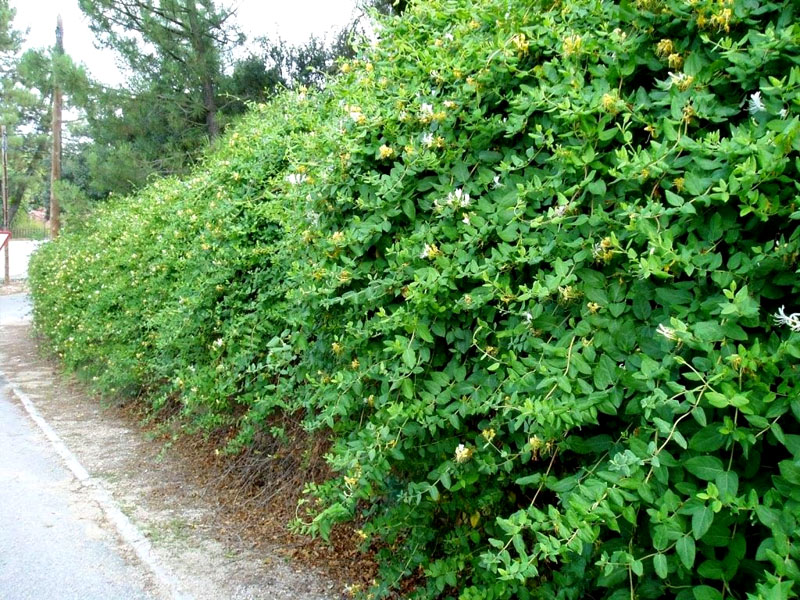
- Willow- a tree with falling foliage. It has been recently used as a living "fence", but has already become quite popular. Willow is frost-resistant and easily propagated by cuttings.

- Campsis- perennial bright liana. It is unpretentious in leaving, quickly grows. Even a novice summer resident can create such an element of decor.
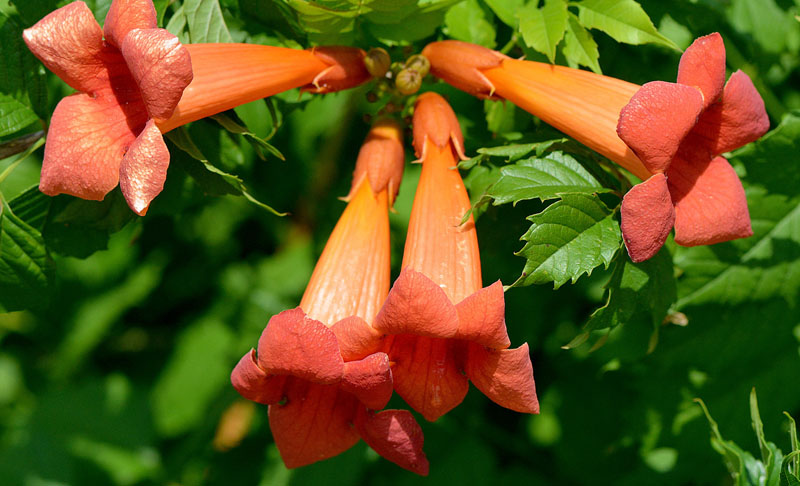
- Cotoneaster brilliant- there is different types: deciduous or evergreen. They have glossy foliage and small flowers. Resistant to frost and not whimsical to the landing site.
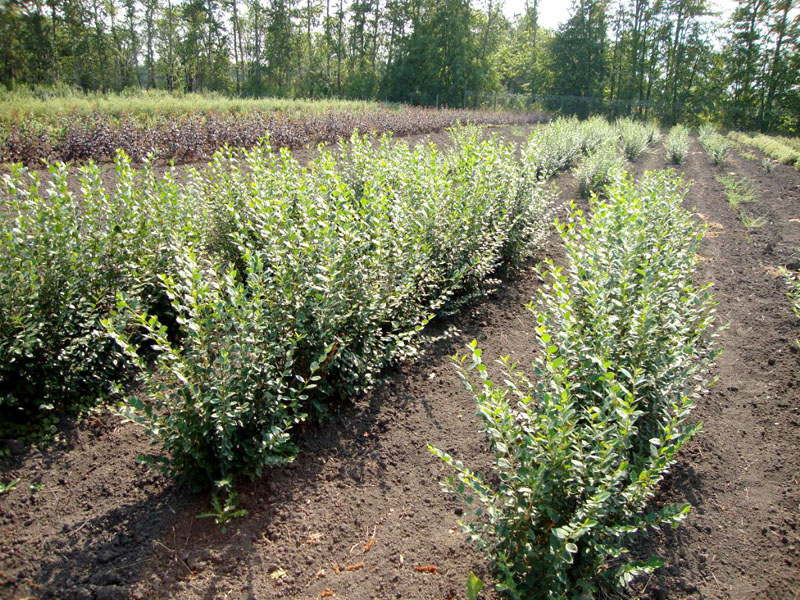
- cypress lawson columnaris – coniferous plant. It reaches a height of 5 to 10 m, a crown diameter of 2 m. The shoots are vertical and tight. Plants can be spaced closely together to create a dense and even hedge.
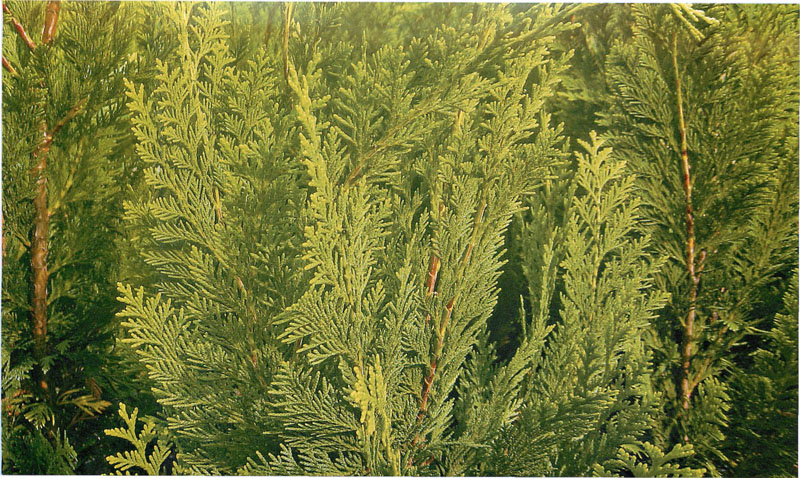
- Cupressocyparis Leylanda- a coniferous plant that should not be planted on clay soils. Suitable mixture of earth with peat or sand in equal proportions. To form a hedge, plants are planted at a distance of 20 to 50 cm.
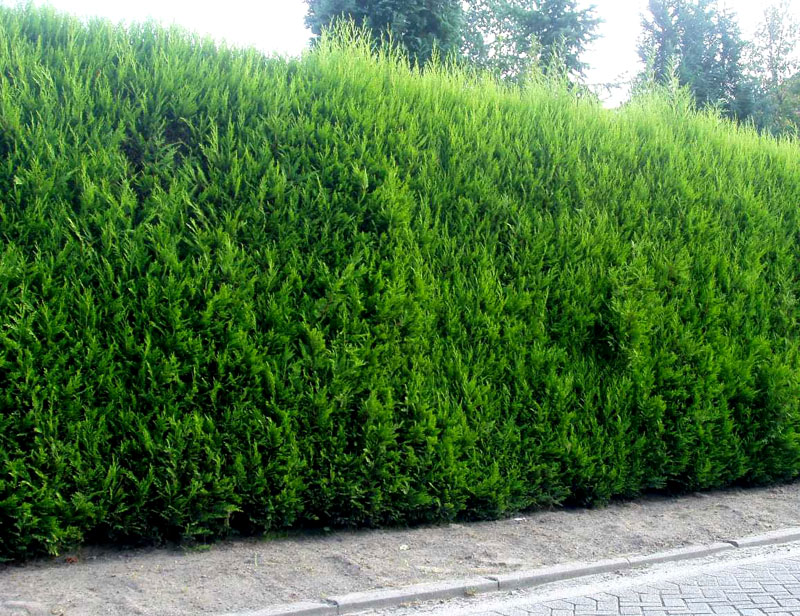
- laurel cherry – perennial shrub. It loves shade and can withstand frosts up to 25 degrees. A fast-growing variety is medicinal laurel cherry, other options grow slowly. Planted at a distance of 50 to 70 cm.
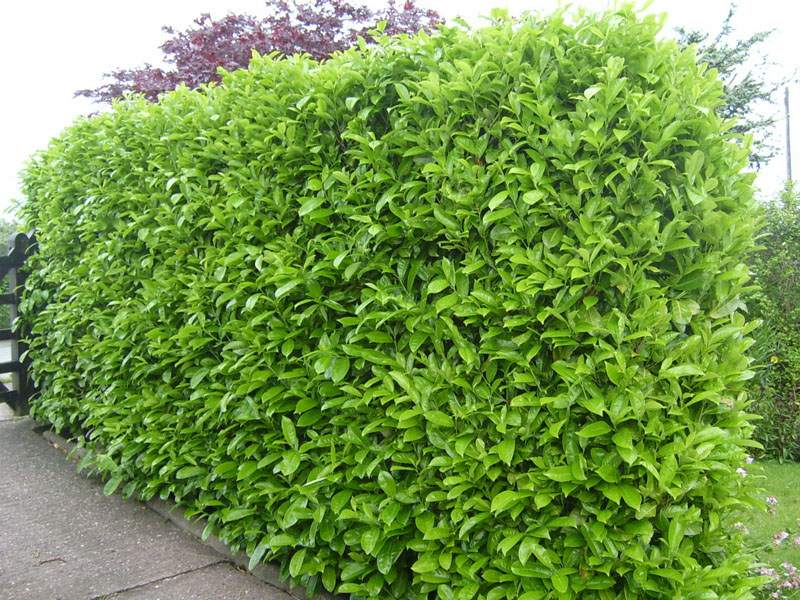
- Holly – evergreen, up to 3 m high. Likes partial shade and nutritious soil. You can not plant in cold regions, and you can cut it no more than once a year.

- Balsam fir- an evergreen plant. Dislikes city life: exhaust fumes have a bad effect on growth and color. Suitable for the middle lane and tolerates frost.
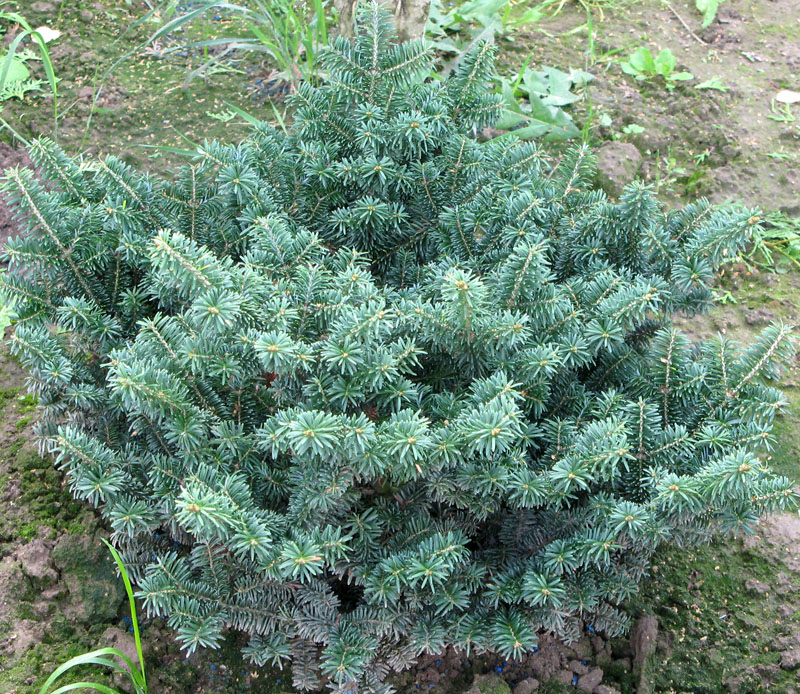
- garden ivy- a climbing plant that is planted next to an ordinary fence. It beautifully braids the design, making it unusual and green. It is unpretentious in care, but do not forget about safety and work with the plant with gloves.
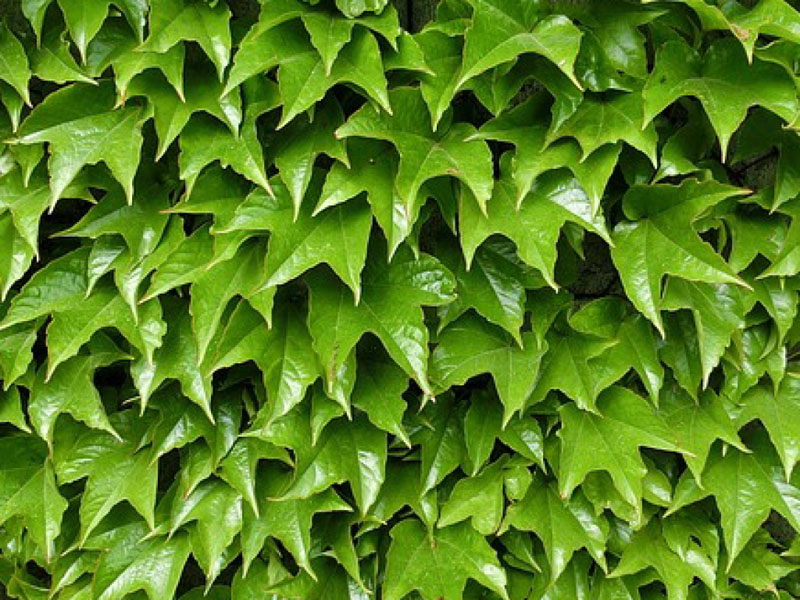
- boxwood- evergreen shrub with long leaves (3 cm). Well suited for landing in the middle lane, and the highest life expectancy reaches 500 years.

- Tuya Brabant- Belongs to the cypress family. There is another name - "tree of life". The evergreen plant is drought tolerant and is hardy and highly resistant to various diseases. You can cut twice a year.
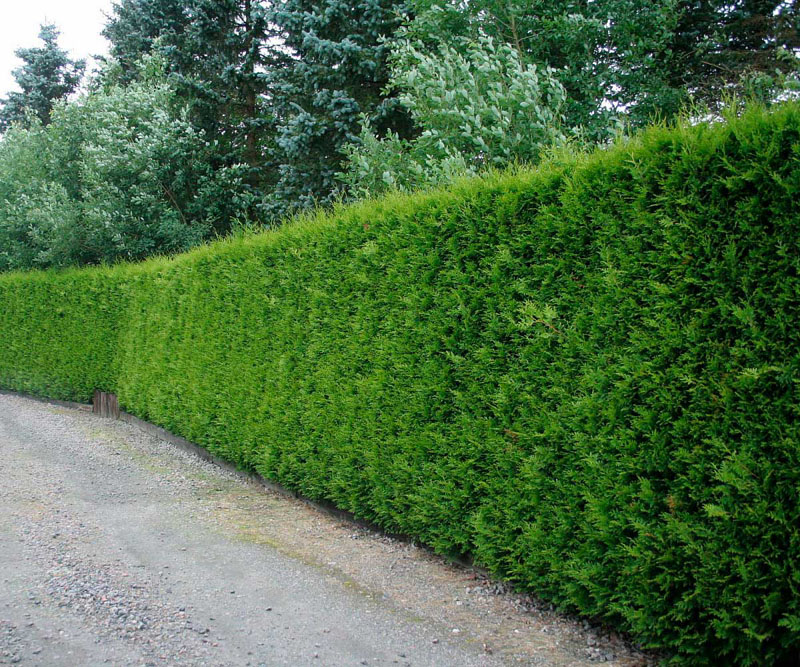
- Thuja smaragd- decorative variety coniferous tree. It has a pyramidal shape, so the plants can not be cut at all. It reaches a height of 10 m, a width of 2 m.

There are other options ornamental plants, which are used to create hedges. The above list is considered the most common for planting and easy to care for. How to properly plant and cut shrubs and trees, we will consider further.
Evergreen barberry: planting and care
Barberry is not just a beautiful evergreen plant used to create an interesting landscape design, but also a healing shrub with edible fruits. Yellow paint is obtained from bark or wood in industry, and berries contain a lot of citric and tartaric acid. They make sweets, jams and other sweets.
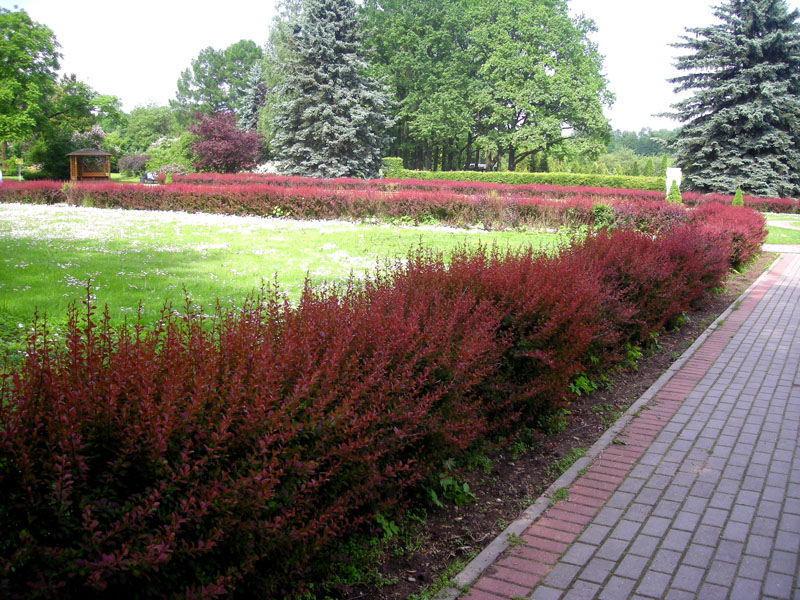
reproduction
Shrubs can be propagated in several ways:
- Cuttings. They are cut and germinated in a greenhouse, you can simply dig up with plastic wrap. As necessary, young shoots should be aired after the first leaves appear. The soil around the landing should be loosened.
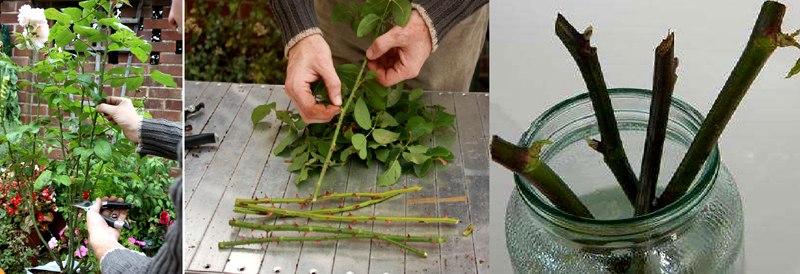
- Seeds. You should choose well-ripened berries. Then, separate the bone from the pulp and treat with a weak solution of potassium permanganate. Sow in autumn in prepared soil before frost. If you want to plant in the spring, then for the winter, place the seeds in soil mixed with sand and leave in a cold place. After six months or a year, shoots will appear from the strongest seeds, which are transplanted to a new place. The plant begins to bear fruit 2-3 years after germination.
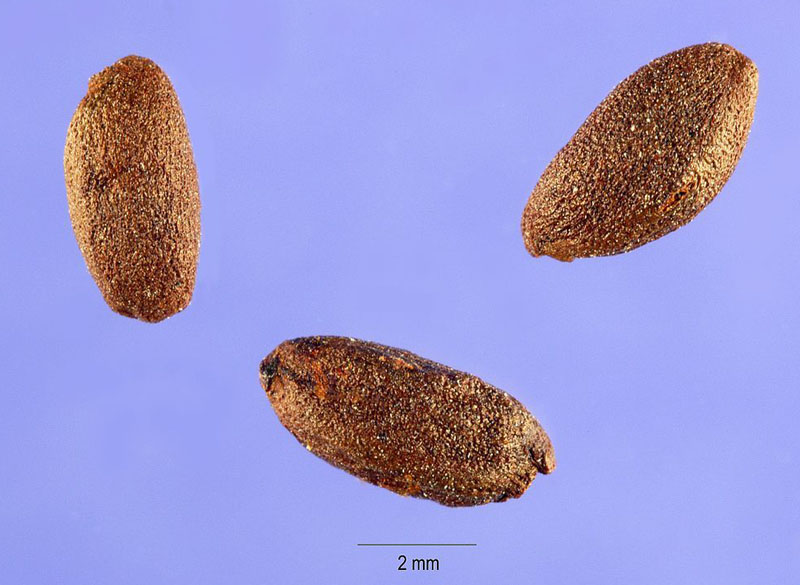
- layering. You choose annual branches on a growing bush, make grooves near the trunk, when the soil dries out, fix branches in them to a depth of 20 cm. Only the top of the shoot is left on the surface.
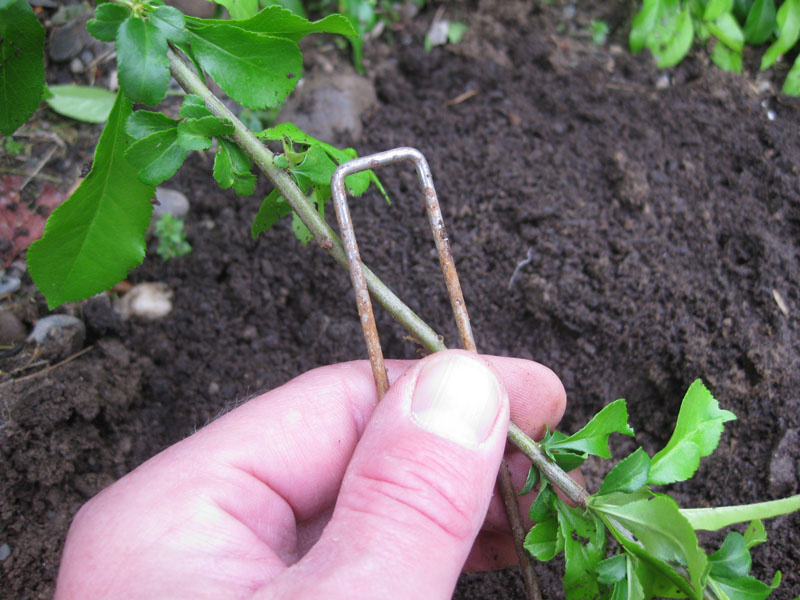
- The division of the bush. Carefully dig and cut the root system of the bush. Be careful not to damage the roots.
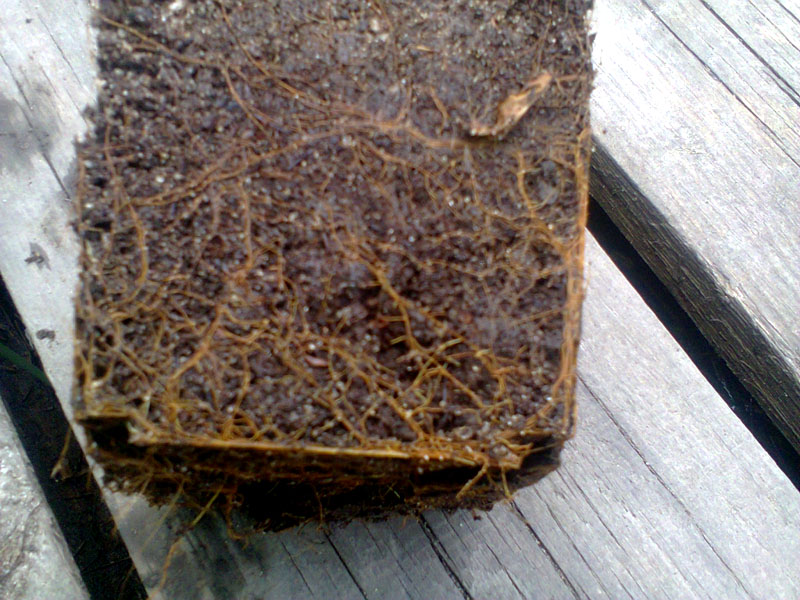
The easiest way is to dig in young branches. You will get a dense hedge by gradually planting the plants in the right direction.
shrub planting
Barberry is unpretentious to the type of soil. It can grow in both normal and highly acidic soils. If on your site the acidity index exceeds all norms, then before planting the plant, add a mixture of lime and earth to the pit. You need somewhere around 400 g of slaked lime and 200 g of wood ash.
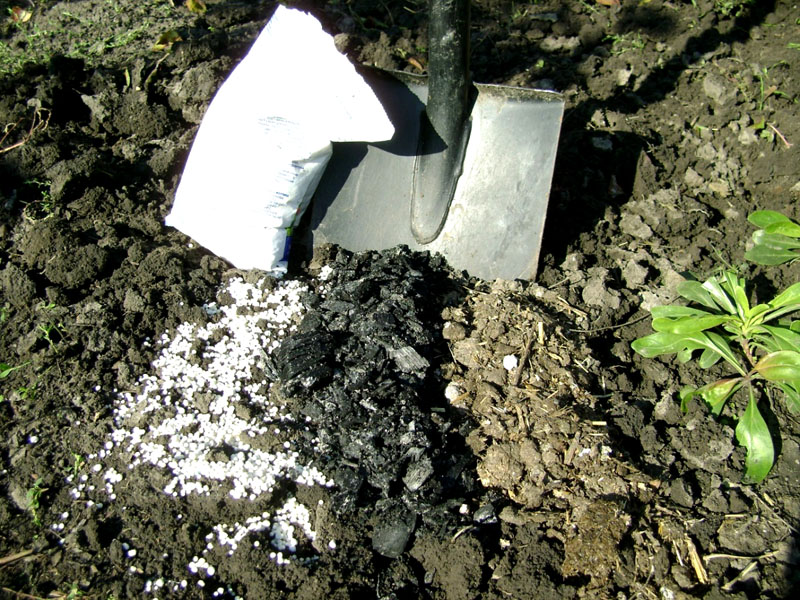
To obtain a hedge, bushes are planted at the rate of 2 plants per 1 running meter. The choice of a sunny or shady side is not critical, as the shrub easily adapts to different environmental conditions.
Summer residents and owners of private houses choose barberries for a reason. It is unpretentious in care and at the same time has a beautiful appearance with edible fruits. Here are some plant care tips:
- once every seven days;
- mineral fertilizers are applied once in the spring, a year after planting;
- loosen the soil often;
- after decorative pruning, remove weak shoots and broken branches;
- You can only cut in June or August.
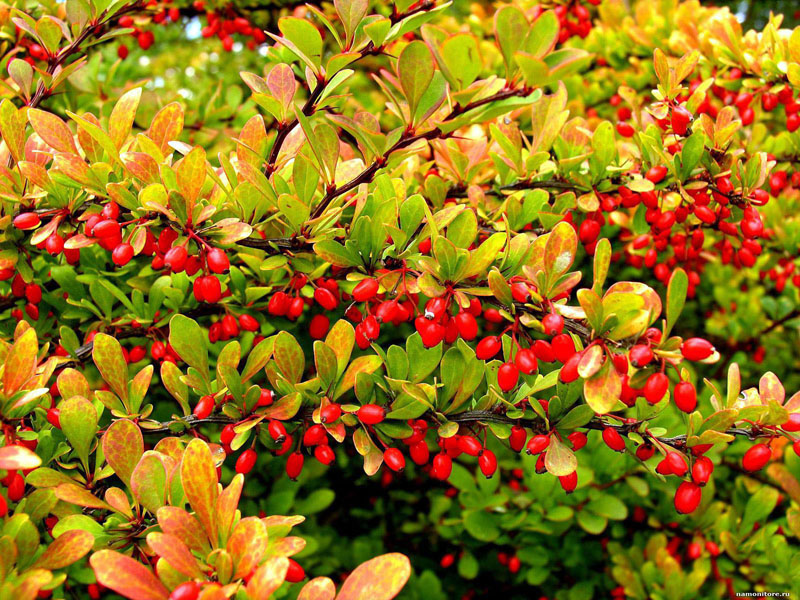
Periwinkle: photo of flowers, and how to care for the plant
An interesting plant with beautiful flowers. It is unpretentious in care, so it is suitable for growing even beginner gardeners. The flower consists of five petals of a pale purple or blue hue.
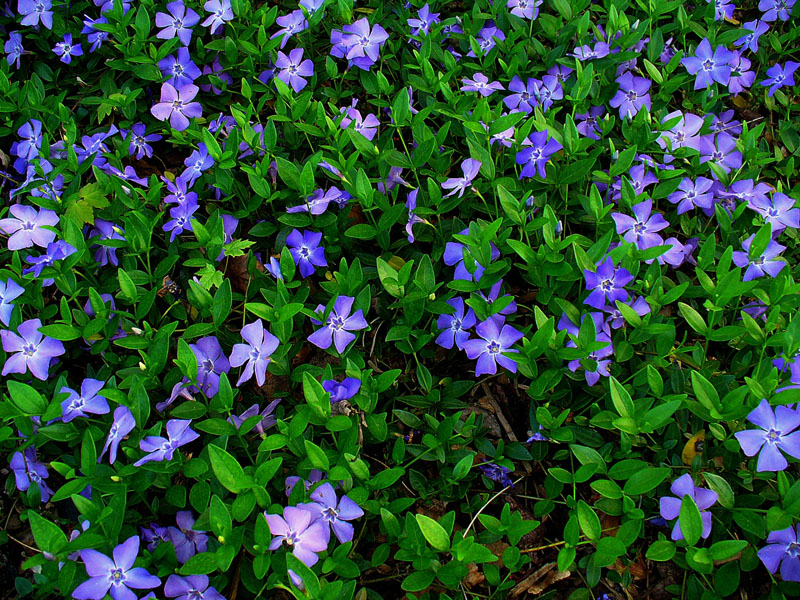
Cope with periwinkle planting and care in open field everyone can. The plant of the selected variety takes root on any soil, it can be planted on the slopes of the plots. The shrub is actively growing, therefore, when disembarking, a distance of 30-35 cm is observed.
You can plant on any soil with a sunny or shady side. In the early stages of growth, it is worthwhile to ensure proper watering, then, the plant does without abundant moisture. In summer, it is enough to water the hedge once every 7-10 days.

Periwinkle does not need subcortex. And it can be propagated by cuttings, seeds, dividing the bush or branch. The easiest way is division, since active growth begins immediately after reproduction.
Advice! Plant the shrub in spring or early autumn, in summer the soil will not be moist enough for the successful growth of a new plant.
Beautiful flowers can also be used as separate elements of landscape design; periwinkle looks good in flower beds in flower arrangements. Here is a video on caring for this plant:
Euonymus: planting and care in the open field
Euonymus is a woody plant, low and evergreen. Use it to create hedges, decorate fences or decorate the site. A single plant looks good on an emerald lawn.

There are about 200 species, each of which looks beautiful and original.
Important! The berries of the bush are poisonous, if there are children, make sure that they do not eat them, despite the fact that they are eaten by birds.
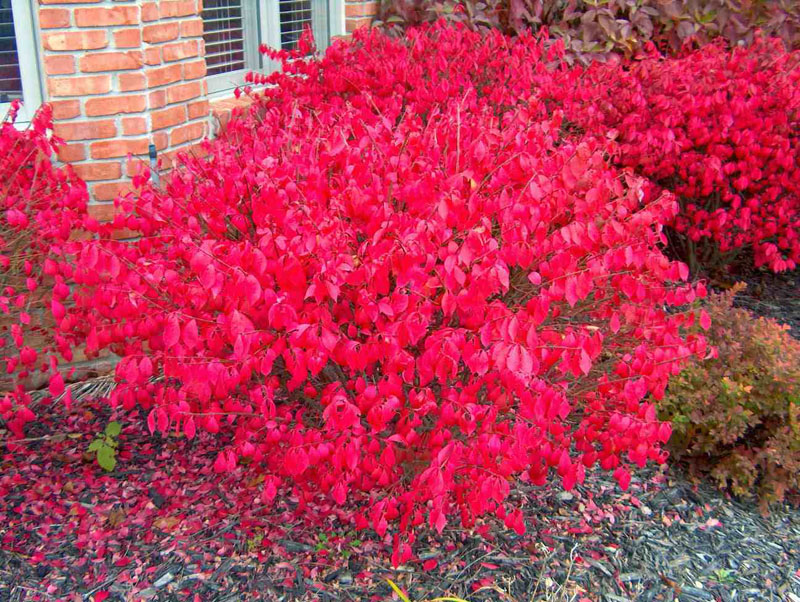
Propagated most often by branches or division of the root system. Rarely use seeds or cuttings. It is important to treat seeds with a solution of potassium permanganate and plant them in autumn to a depth of 2 cm.
Soil selection, planting sites and care
| soil type | Suitable for slightly alkaline rocks. If the soil acidity is increased in your area, then a mixture of lime and ash should be added to the soil before planting. |
| Place to land | The plant grows faster in width, so plant a hedge at a sufficient distance from other trees. |
| Care | It does not tolerate frost, so it should be covered for the winter, and the soil around the trunk should be covered with fallen leaves. In the summer, in the heat, it requires increased watering. |
| pruning | You can prune several times during the summer, while removing dry branches and broken shoots. |
| Pests | Subject to attack by caterpillars, aphids, mealybugs and molds. They are processed in the same way as fertile trees in a regular garden. |
Privet - a hedge for your site
Privet is a common element of landscape design. Refers to the role of olive and evergreen shrubs. It occurs naturally in the undergrowth. The plant is not whimsical to the ground, tolerates drought and frost well. Suitable for landing in central Russia.
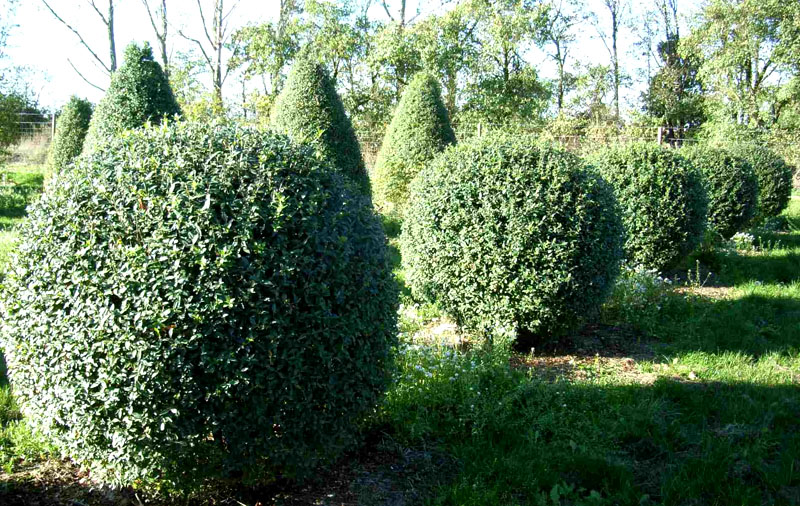
Privet takes root well in the city and the countryside, the shrub is not affected by exhaust gases or atmospheric pollution. Grows well in open and fairly moist areas.
For planting single bushes, pits are dug 40 cm deep. To create a hedge, add a substrate (earth mixture) from ash (300 g per linear meter) and lime (150 g) to the trench, and also include mineral fertilizers in the amount of 70 g.
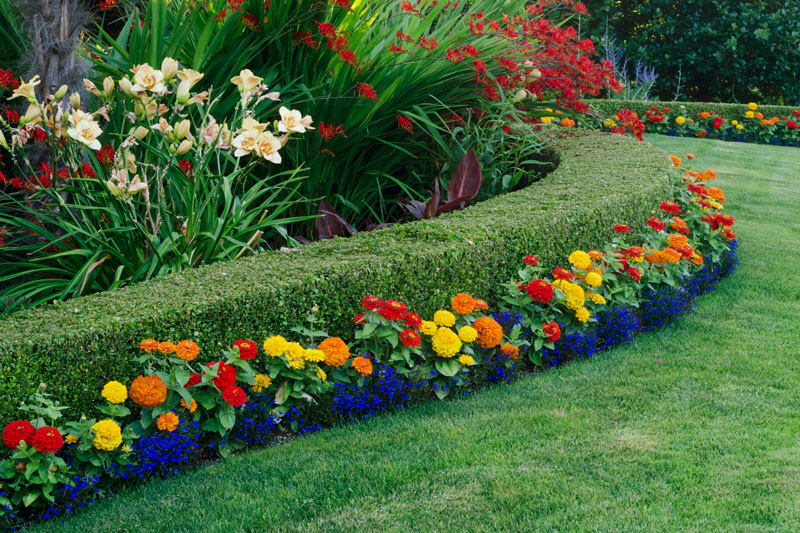
Plant plants on the sunny side, as it comes from southern countries. And the care complex includes watering, which is especially important for young shoots, fertilizing with mineral fertilizers in spring and pruning. Even if you don't specifically shape the hedge, you should keep it sanitary.
It is best to propagate by branches or cuttings. You can use seeds or division of the rhizome. Here is a video on care and reproduction:
Long-lived, undemanding plant - hawthorn. Able to bloom and bear fruit from the age of 10-15 years. It does not require special care and is perfect for creating a hedge in central Russia.
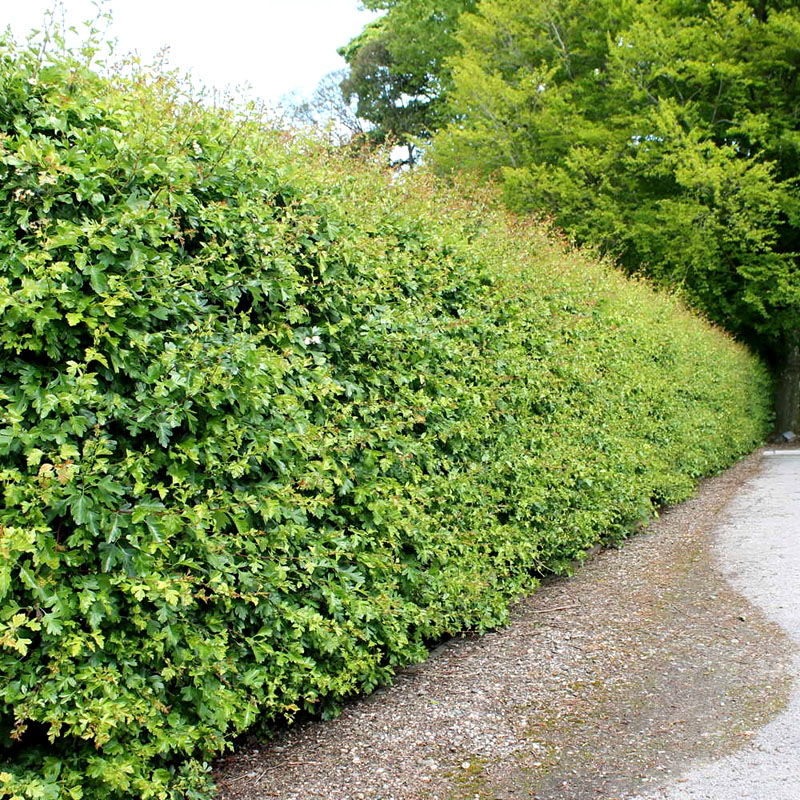
The root system is deep, so you can only transplant up to 5 years. He loves the sun, in the shade it bears fruit and blooms worse. Grows on any soil. And it is best to propagate by cuttings.
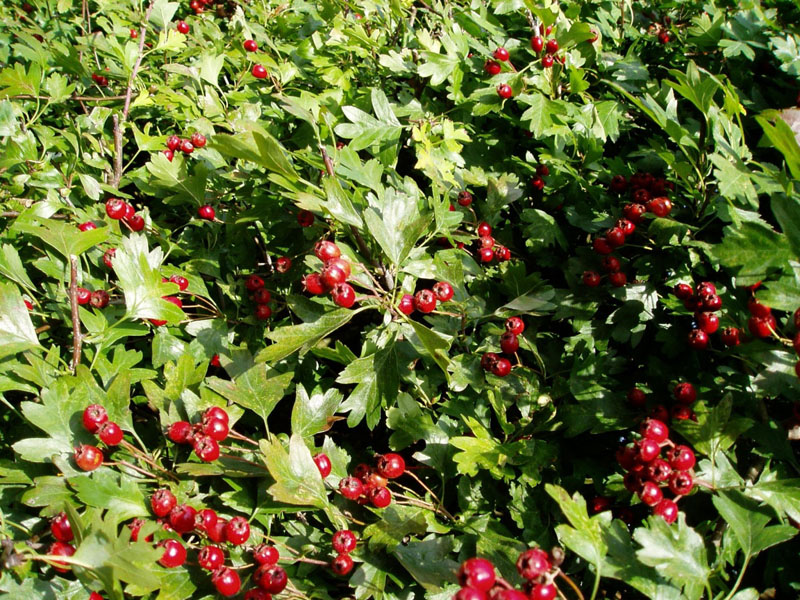
To give the hawthorn hedge density, cut the plants and plant them at a distance of 10-15 cm. Use a trench, up to 1 m deep. In the first year of life, all shoots are cut at a height of 15 cm. In summer, you can shorten the lateral branches to stimulate growth. In the second year, the main branches can be cut in half, and the side branches shortened again. And on the third, proceed to the formation of the desired shape, conducting a “haircut” 4-6 weeks before September.
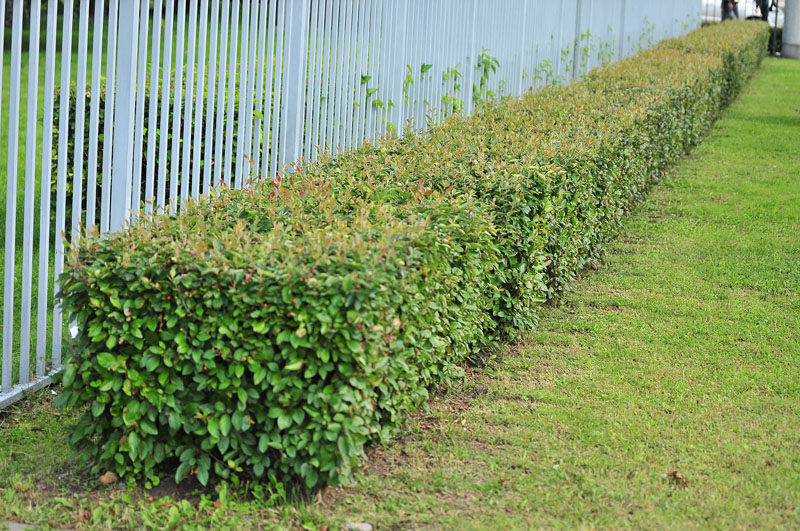
Here is a video on the features of caring for this decorative hedge and growing the bush itself:
spruce hedge examples
Norway spruce is the most common plant in the middle lane. She has not only external beauty, but also an indescribable smell of pine needles. On the site, such trees look great, well cleaning the air from pollution.
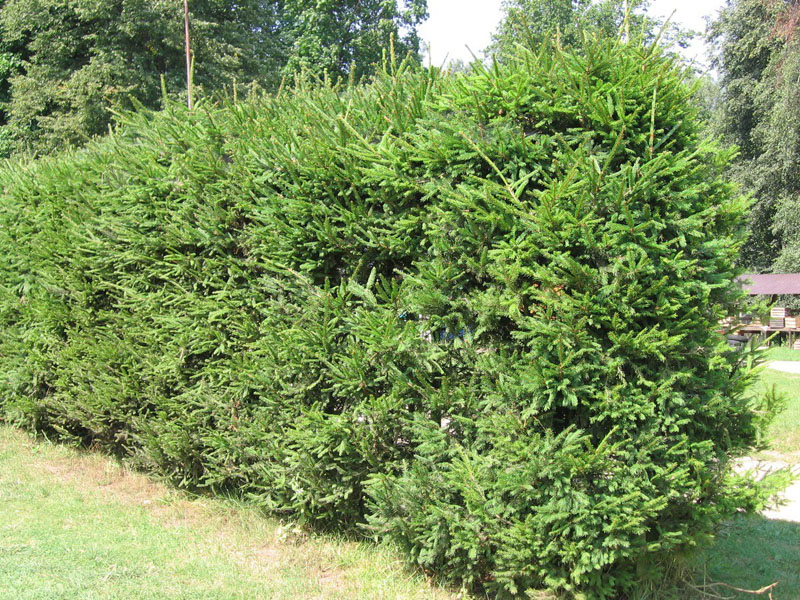
So that it does not reach its natural height of 50 m, it should be cut. Planted in a trench with a depth of 0.5 m and a width under the root system. Spruces do not like an abundance of moisture, so you should create a drainage layer in the trenches, filling the bottom with crushed stone or expanded clay by 20 cm.
To prevent the root system from drying out, the roots of the seedlings are lowered into the clay mixture before planting on the site. Shearing in the first year of life is impossible. Otherwise, the tree does not need special care, except for regular treatment from pests such as aphids, caterpillars or spider mites.
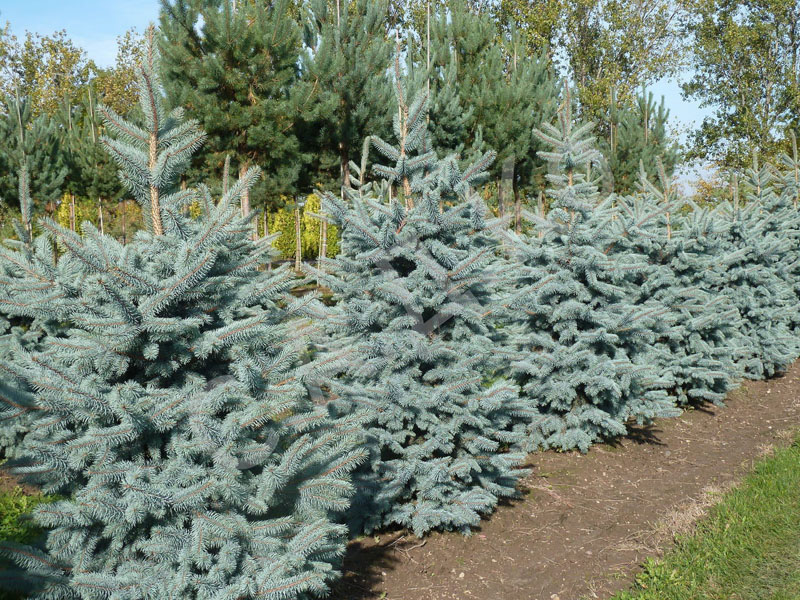
Here are photo examples of beautiful hedges and landscape design options with spruce:
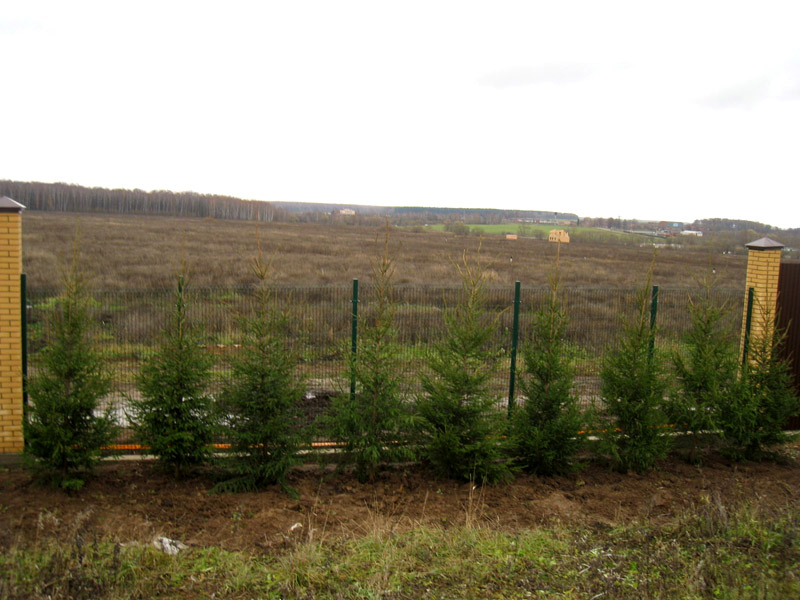
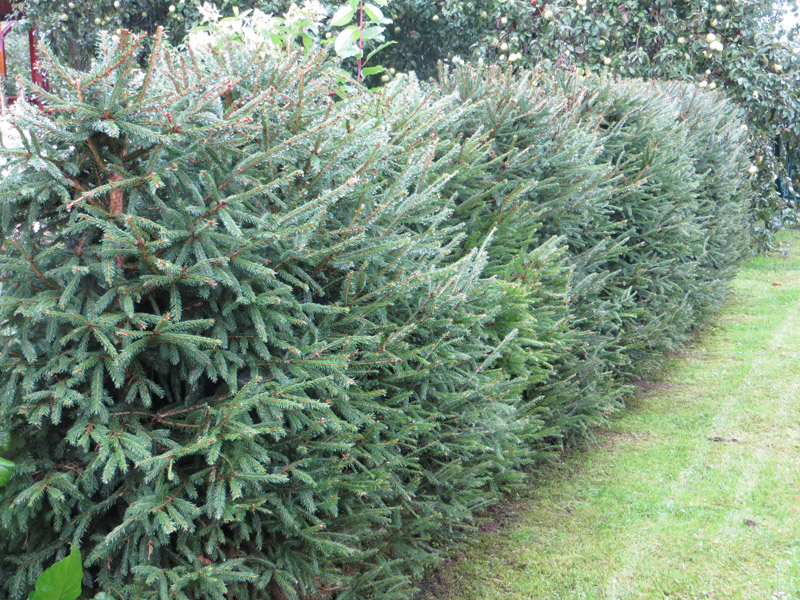

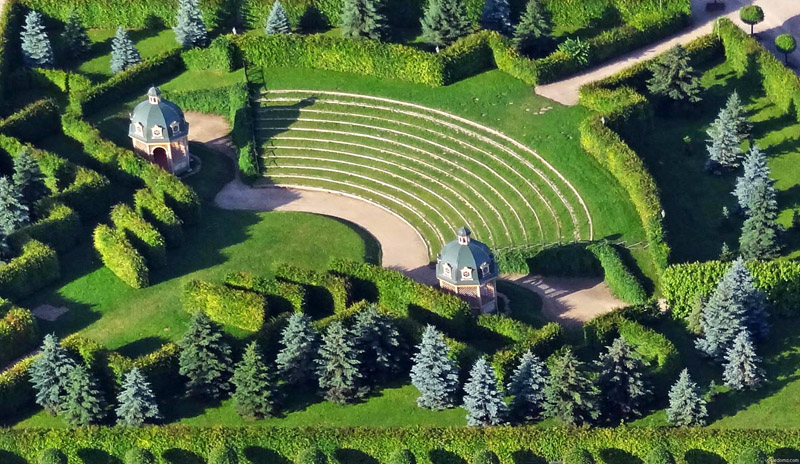
Honeysuckle honeysuckle: planting, care, plant photo
The honeysuckle honeysuckle variety is an unpretentious plant suitable for any type of mail. It blooms luxuriantly in the sun, and is best planted in October.
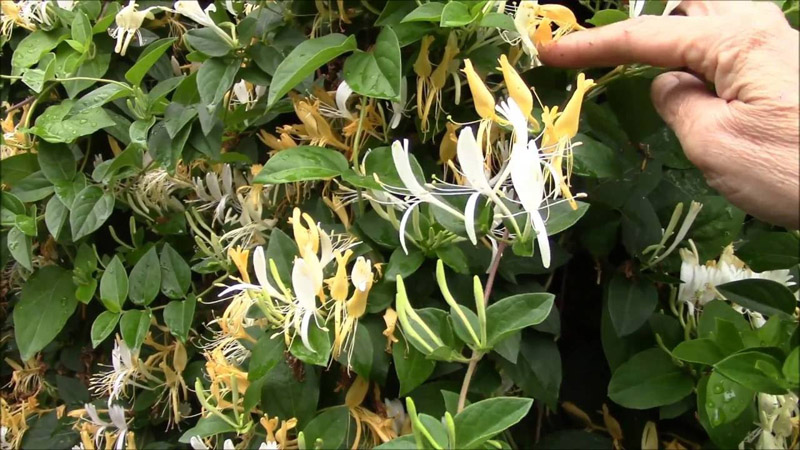
For planting, prepare a hole 0.5 m deep and add humus and wood ash to the bottom. Make sure that when planting, the root system is 5 cm below the soil level. After digging in, the soil around should be covered with peat in a 3 cm layer.
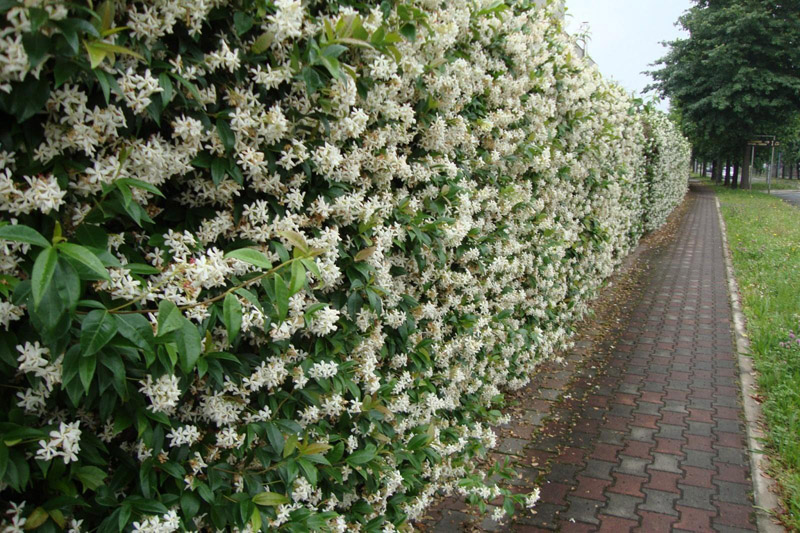
The plant is not afraid of frost, so it is perfect for the middle lane.
Important ! When cutting old shrubs, leave stumps 30-40 cm in height, otherwise the entire root system may die.
After rejuvenation, the shrub can grow strongly, then thin out the next year, leaving 10-15 of the strongest branches. Here is a video on proper care and planting of a plant:
Willow hedge: planting features
Willow fences are becoming more and more common. Its beautiful branches falling like a waterfall attract attention, and often planted trees allow you to close the area from prying eyes.
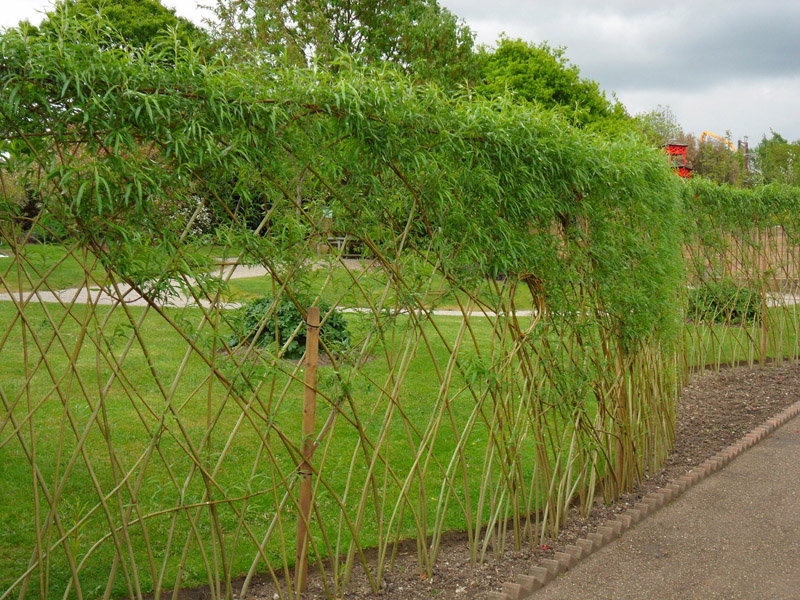
To create such a living barrier, cuttings harvested in autumn or spring are best suited. It is best to use annual shoots that are cut in the fall and stored in a cool room.
You can buy ready-made seedlings, paying attention to their root system, which should not be dry. Cuttings easily take root in any moist soil, but acidic soil is recognized as the most suitable.
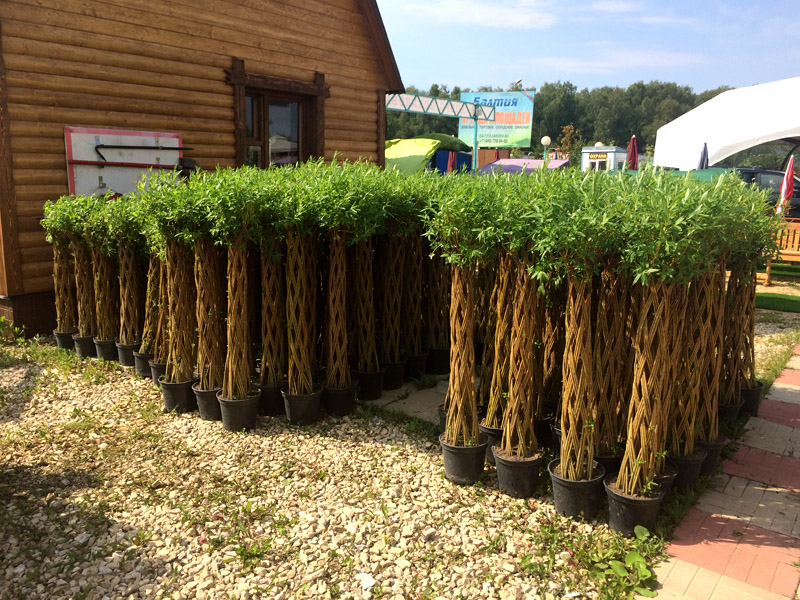
To create a living fence, mark the perimeter of the site. Dig a trench 40-50 cm deep. It is necessary to plant the shoots next to the driven pegs, since the seedlings will need a frame. It is necessary to plant at a distance of 20 cm and at an angle of 45⁰.
The plant is fed 2-3 times with complex mixtures, and at the end of summer, potassium sulfate is added to the soil. With proper care, such a fence will last up to 50 years.
Campsis large-flowered planting and care in the open field
An amazingly beautiful liana that grows rapidly and braids the selected section of the fence.

When planting, one nuance should be taken into account - the root system is actively developing and filling all the nearby space. When planning a planting, consider how to protect other plants from the aggressive roots of Kampsis grandiflora. For example, put in a narrow passage between buildings.
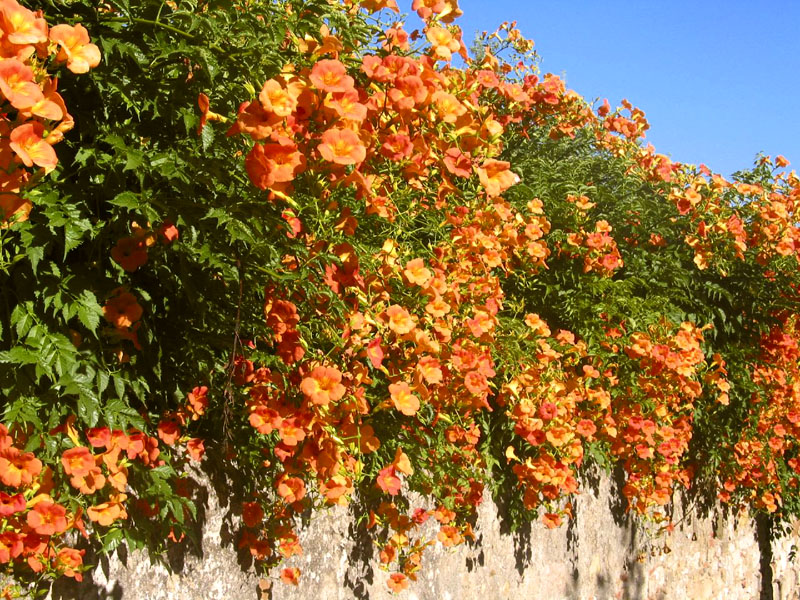
The plant loves a lot of heat and sun, and for good growth the soil should be loose and slightly acidic. Planted in a hole 50 cm deep, where humus and complex fertilizers are added. At the bottom, it is desirable to pour expanded clay or fine gravel.
You can plant in early April, if repeated frosts are not expected, and buds have appeared on the seedlings.
Important! Consider in advance a support for the growth of the vine.
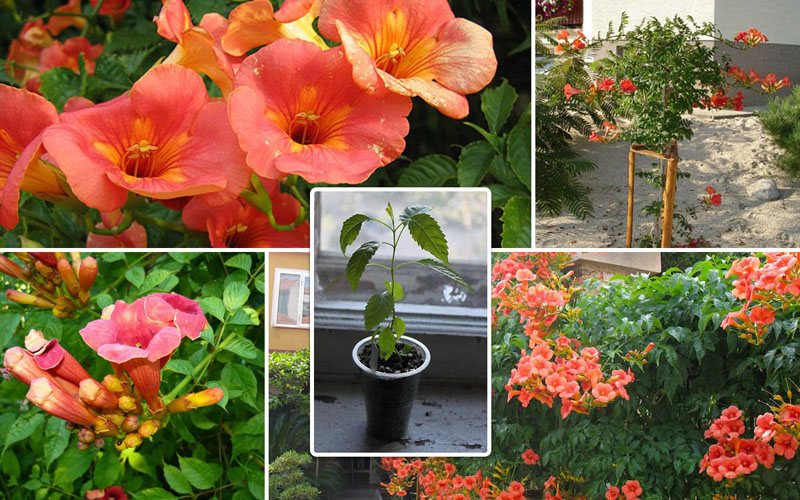
It should be watered regularly, but not allowing waterlogging. You can cut as needed, and the plant does not need to be fed at all. Below is a video on proper care and planting:
Brilliant cotoneaster - hedge: photos of interesting solutions
The cotoneaster is brilliant in planting and caring, so even an amateur gardener can handle such a hedge or plot decor option. It's upright deciduous shrub, reaches a height of 2 m, and inflorescences consist of 5-8 flowers. Begins to bloom in May. The fruits are round and berry-like.
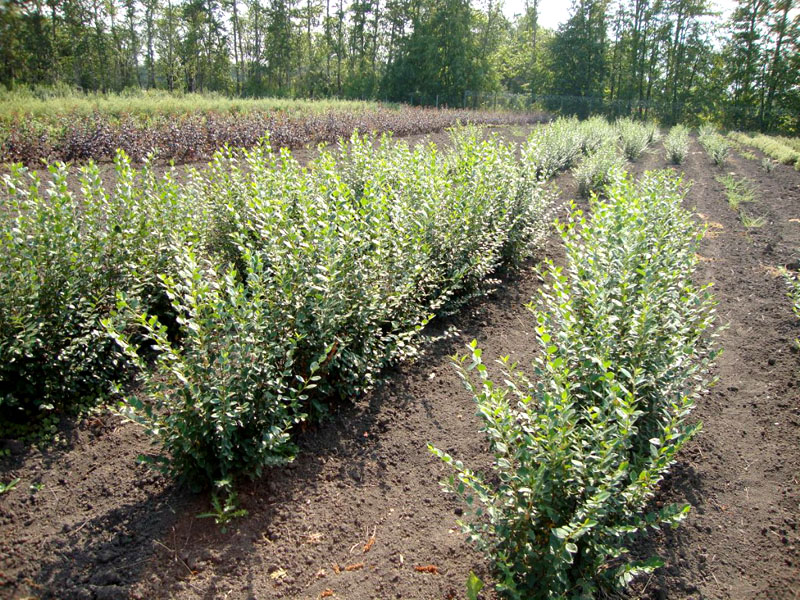
| Planting seeds | Seeds should be planted densely, not all seedlings give. It is impossible to plant a plant for the first 1-2 years, during this period they will germinate by 30 cm. |
| seedlings | They are planted at a distance of 1-2 m in a trench 60 cm deep. A layer of drainage is laid down the pit. |
| Location selection | It grows well in the shade and in the sun, but does not like strong winds. |
| The soil | Dry soil with deep water table |
| Watering and fertilizing | Feed in the spring with organic or mineral mixtures. And water the soil around the shrub during transplantation or severe drought. |
Photo examples of hedges from brilliant cotoneaster:
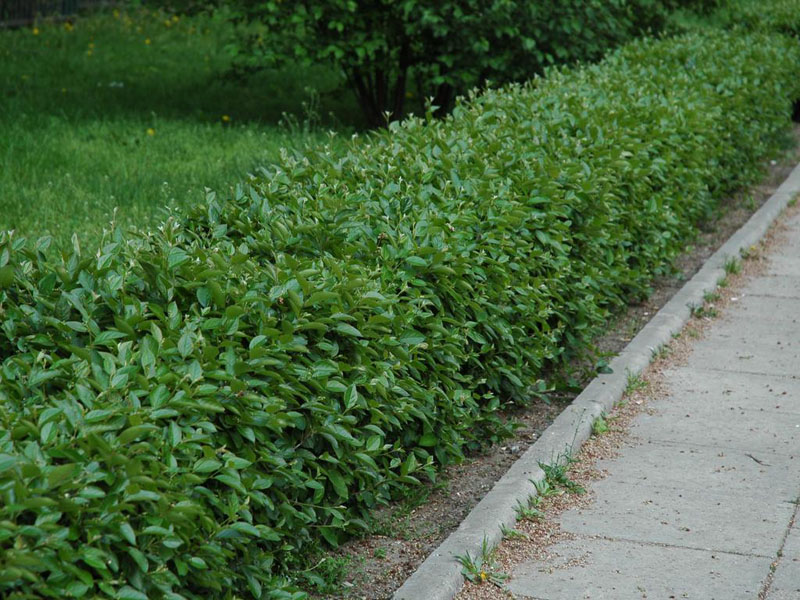
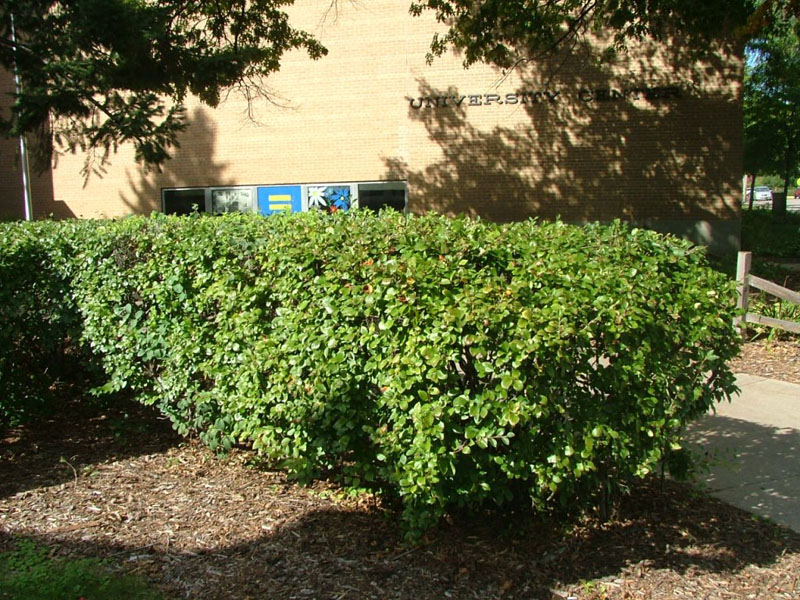
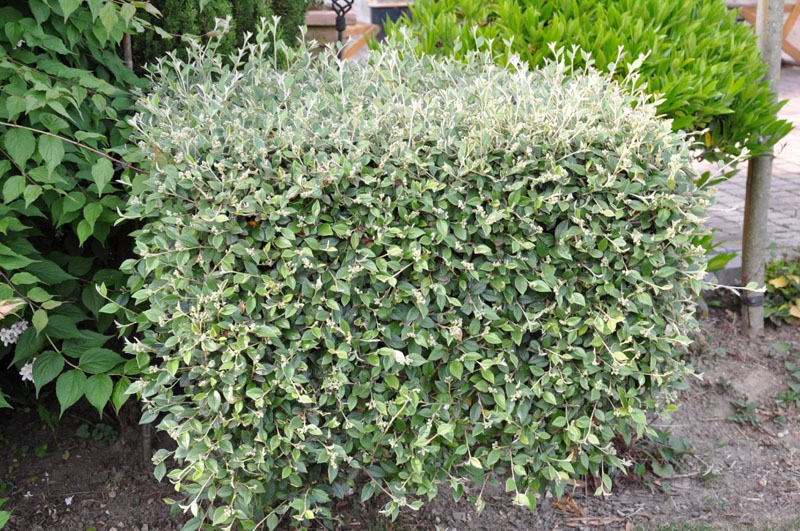
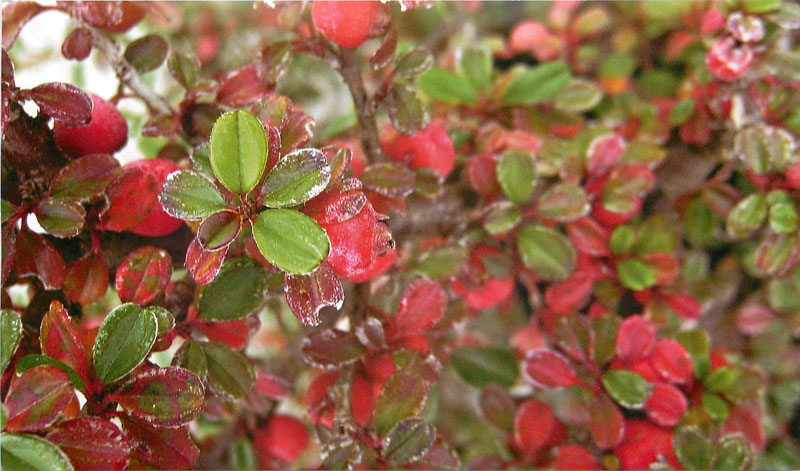
Photo cypress lawson columnaris as a hedge
Cypress lawson columnaris is a low evergreen tree, unpretentious in care and suitable for creating a living "fence". It reaches a height of no more than 10 m. The root system is well developed and high resistance to frost.
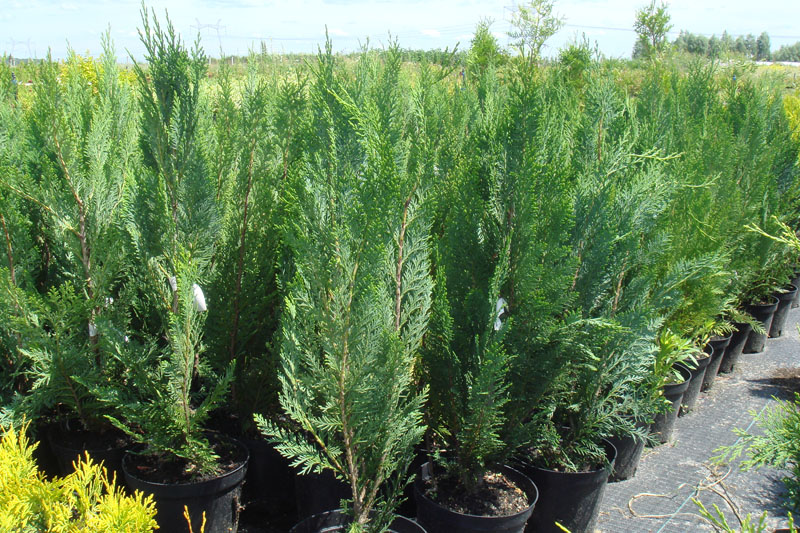
Photo examples of a green fence:
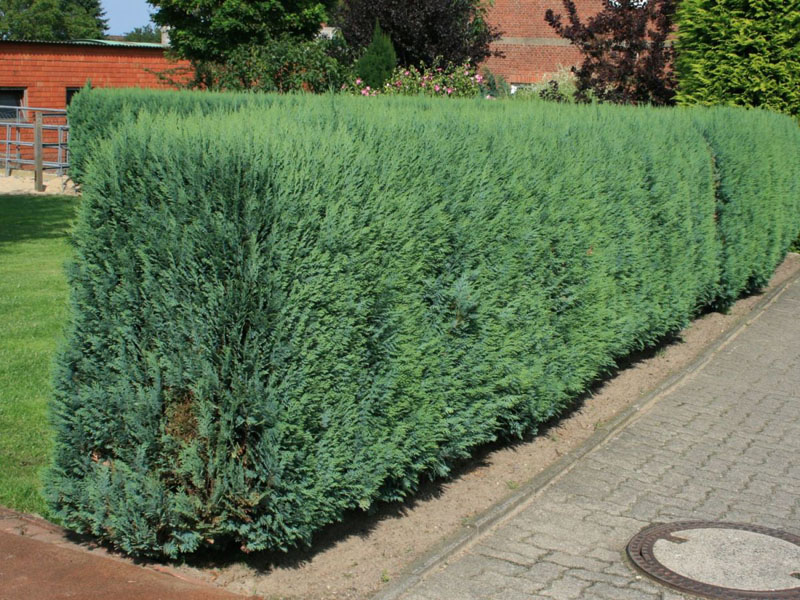
Cupressocyparis Leylanda: planting and caring for the plant
Cupressocyparis Leylanda is an evergreen cone-shaped plant. The dense crown and shoots hanging down make it possible to create a dense hedge. The size of one tree is up to 30 m in height and 3-5.5 m in width. In order to prevent such huge dimensions, the plant should be cut and rejuvenated in time.
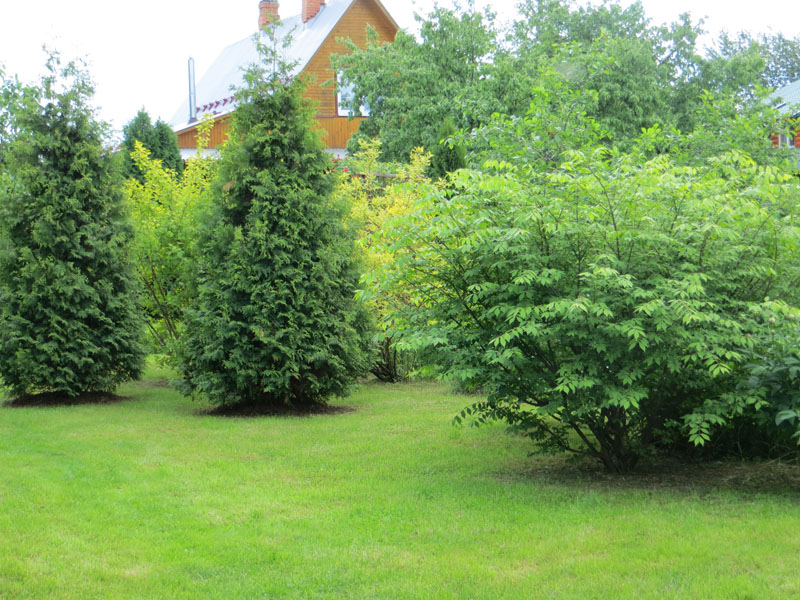
It is unpretentious to the soil and tolerates shade well. It is better to plant seedlings in a trench at a distance of 40-60 cm.
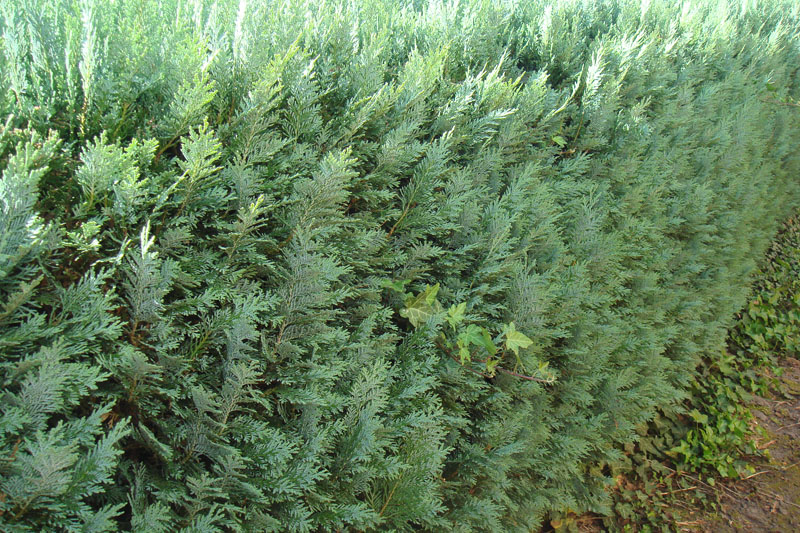
Lavrovishnya: description and photo
The option of a fast-growing laurel cherry hedge is perfect for the middle lane with severe frosts. Outwardly, this shrub is a cross between laurel and ficus.
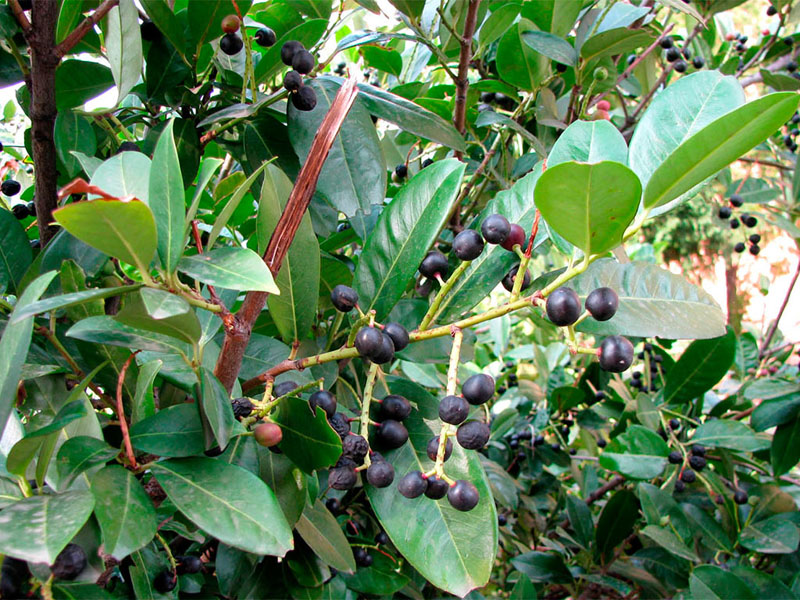
There are dwarf varieties and regular ones. The second ones reach a height of 10 m. The tree bears fruit and the berries are edible sweet in taste, but many decorative options are already deprived of the ability to bear fruit.

Special care is not required. It tolerates shade well and is practically not susceptible to any diseases and pests. Easily propagated by seeds or layering, and also sold in cuttings.
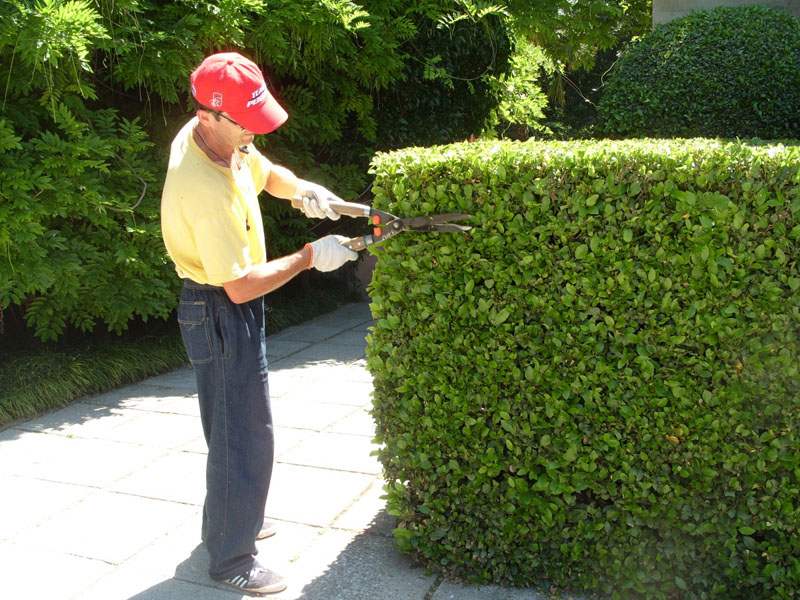
Plants lend themselves to any form of decoration: pruning, bending, entwining around the net. Therefore, it is so common as a decorative element for creating hedges.
Holly: photo planting options
Holly loves shade and moisture. The leaves are sharply toothed and the fruits are bright red. Propagated by seeds and used as a hedge or for a single decoration in combination with other plants:
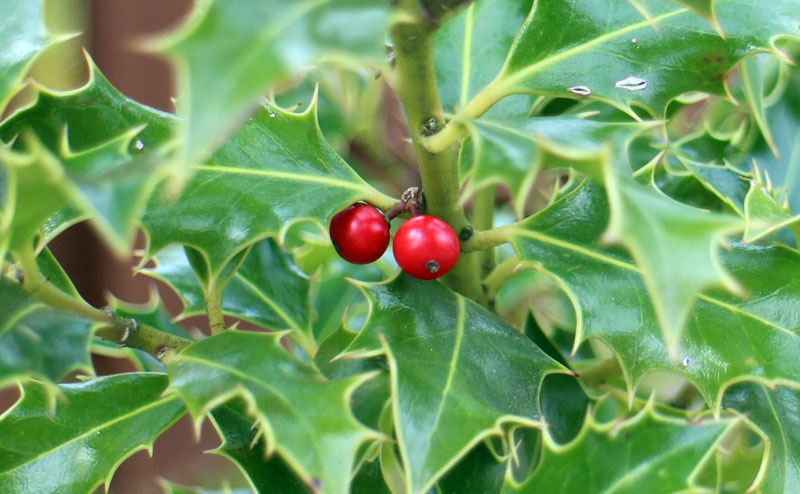
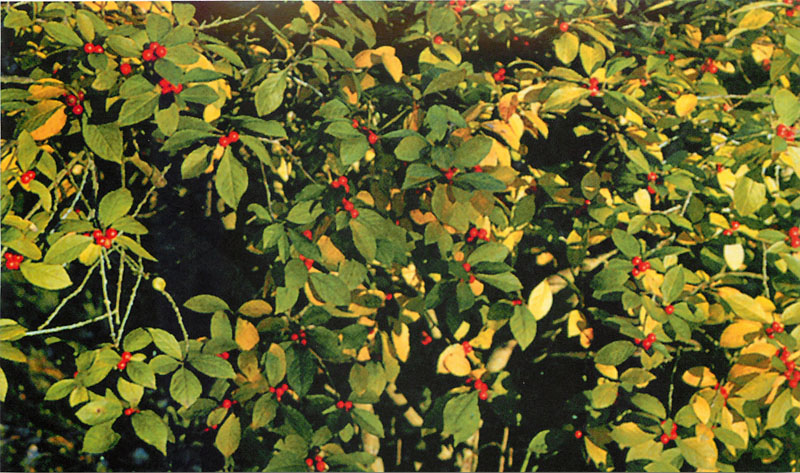
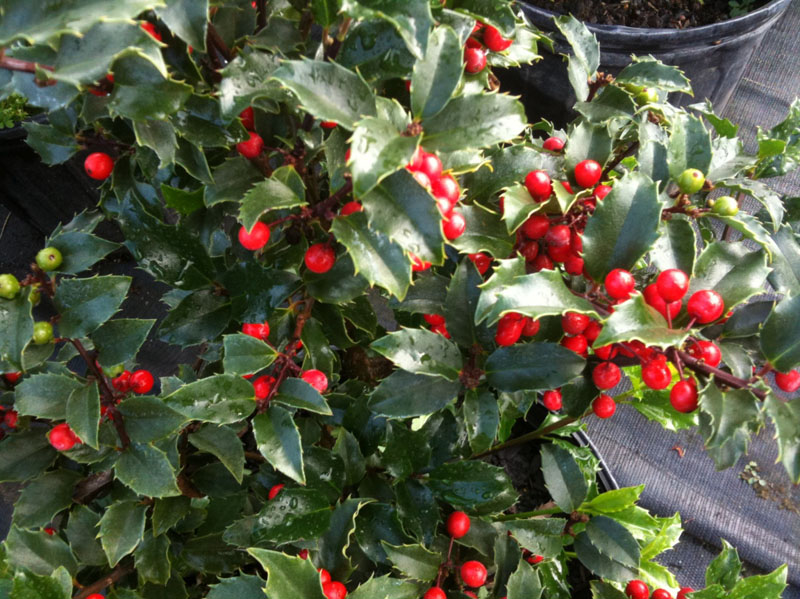
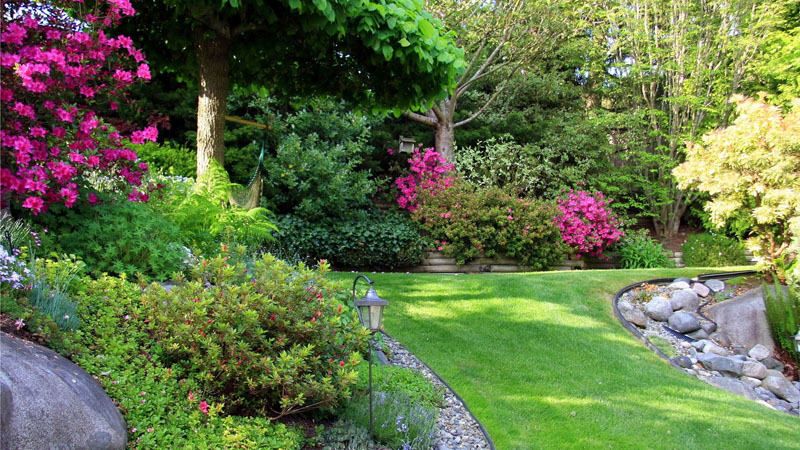
Balsam fir: description and photo
Belongs to the pine family. It is a coniferous, evergreen plant that is frost tolerant and undemanding. Under natural conditions, the tree reaches a height of 35 m, but in decorative versions it varies from 50 cm to 2 m in height.
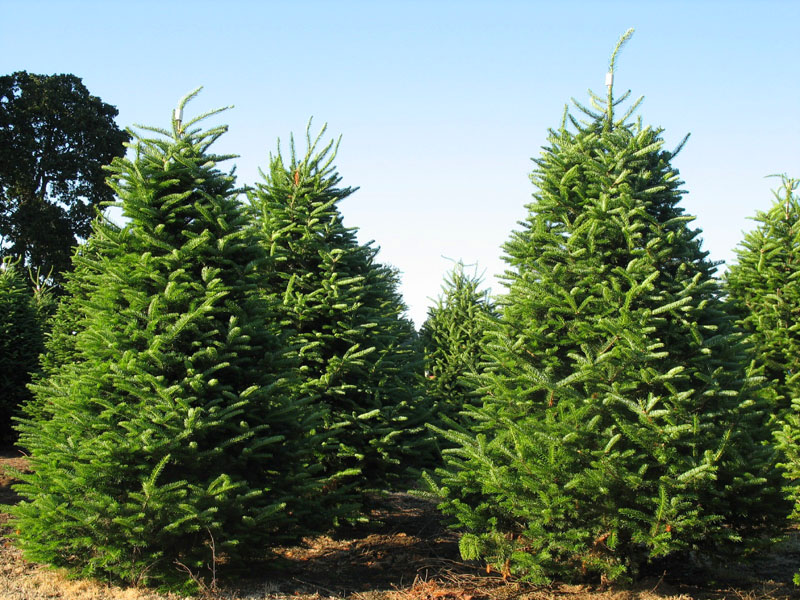
It prefers dry soil, therefore, at high humidity, a 20 cm drainage layer of medium-sized crushed stone or broken brick is poured into the trench before planting. The soil should be fertilized with a mixture of mineral fertilizers. A pit measuring 50 by 50 cm is prepared for one plant.
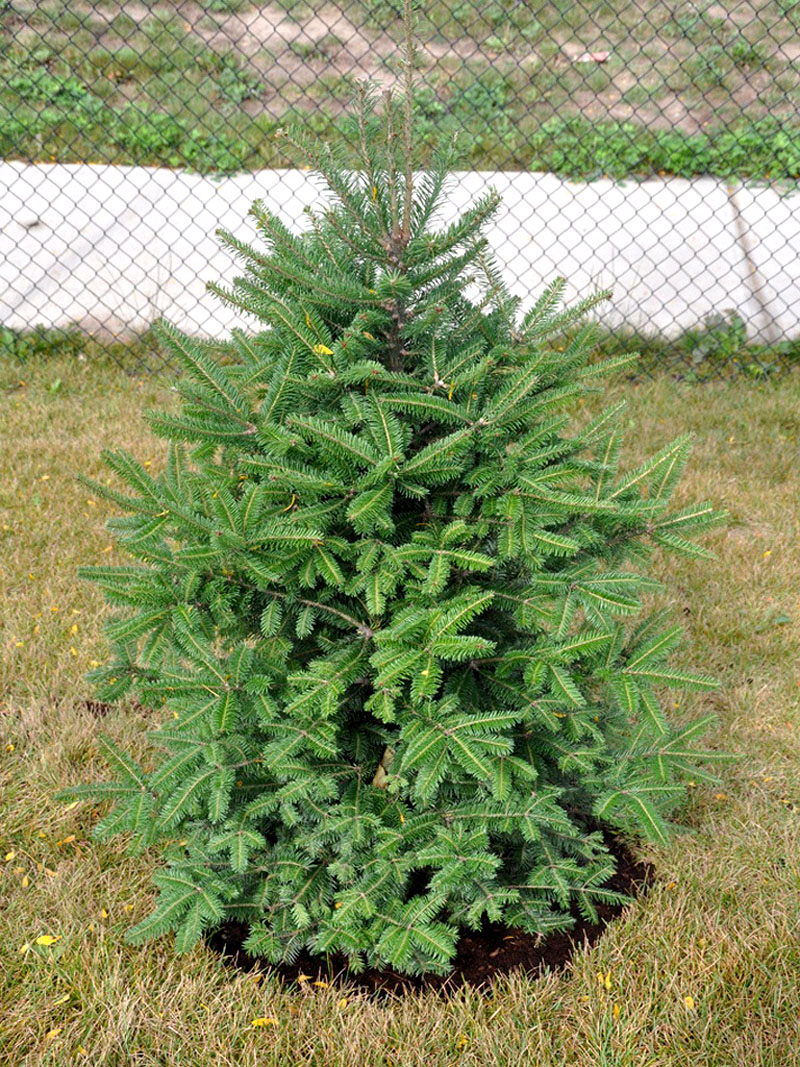
The plant tolerates frost well and develops in the shade. Requires decorative pruning with the removal of dry branches. You should not place fir in areas with strong gusts of wind: the roots are too close to the topsoil.
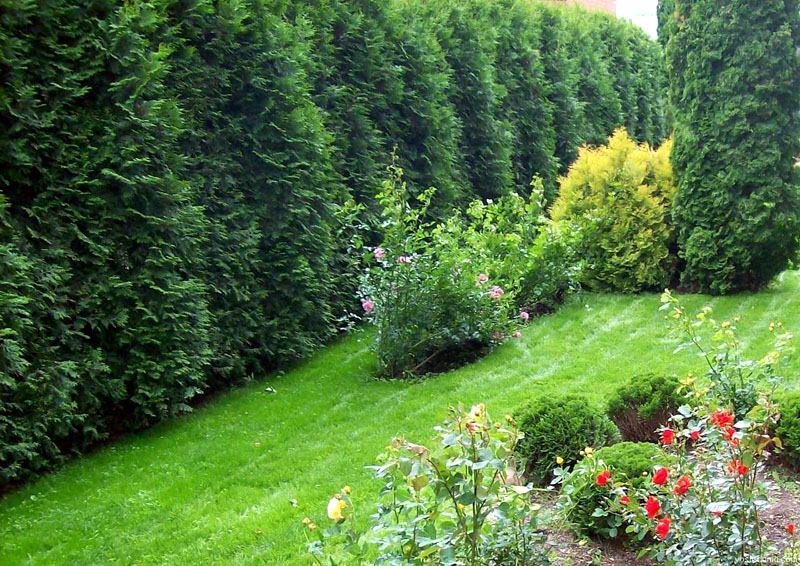
Photo of a garden ivy hedge
Perennial climbing plant of variegated color with red streaks or yellow patches. There are leaves with a white border. Looks beautiful on any fence or hedge, can braid. Inflorescences are collected in umbrellas, in total there are about 15 species.
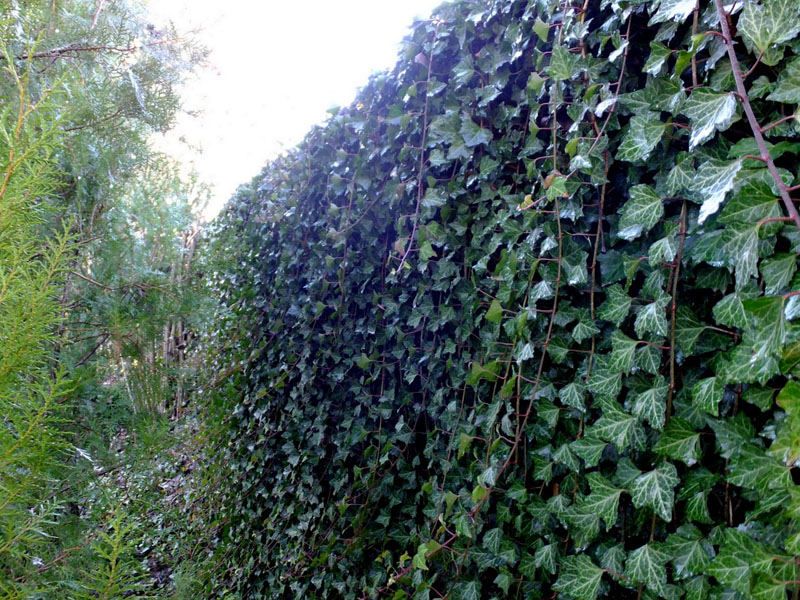
The fast-growing variety includes the Colchis variety, where the shoots reach 30 m in length. Liana grows well in soils rich in lime, so before planting in the pit, add slaked lime with wood ash, and also apply a fertilizer complex.

For abundant growth, a plant that loves moisture should be properly watered. And do not forget that working with cutting vines is worth wearing gloves.
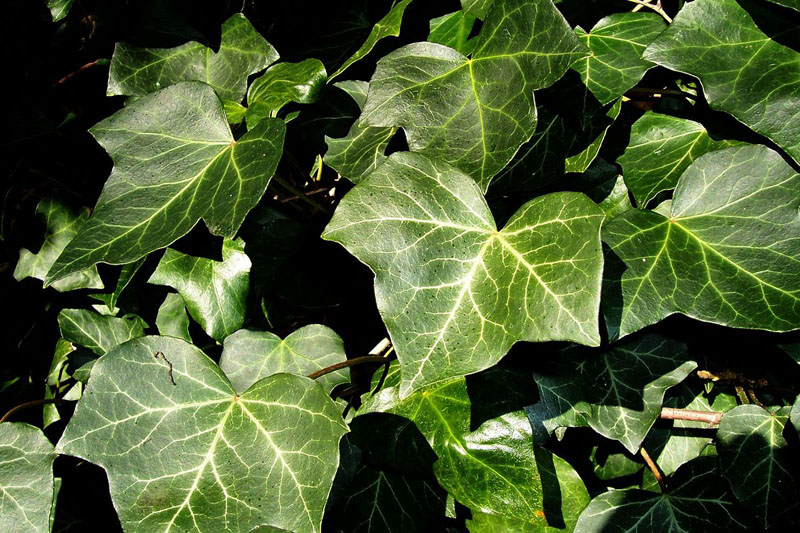
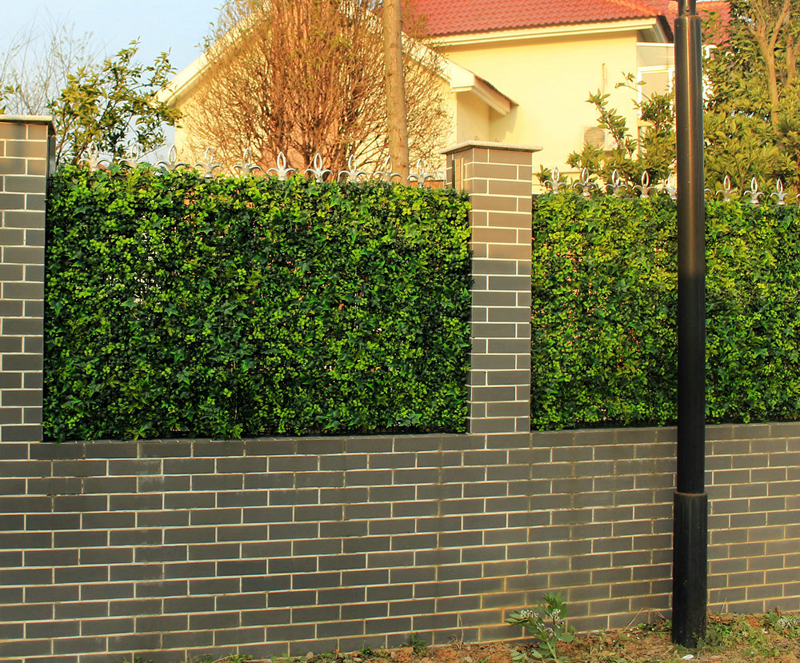

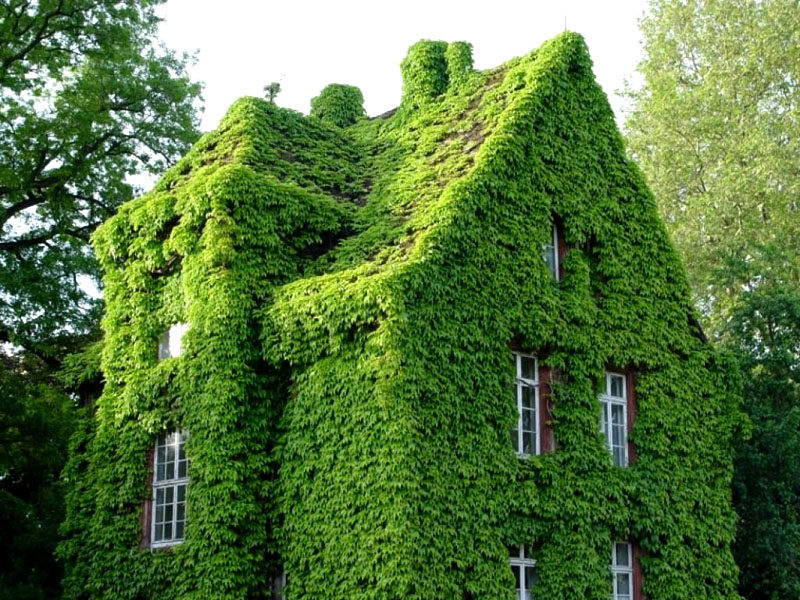
Boxwood: planting, care, reproduction
Boxwood is an evergreen plant that any gardener can plant and care for. Belongs to one of the most ancient species ornamental shrub, pleasing with greenery and in the winter cold.
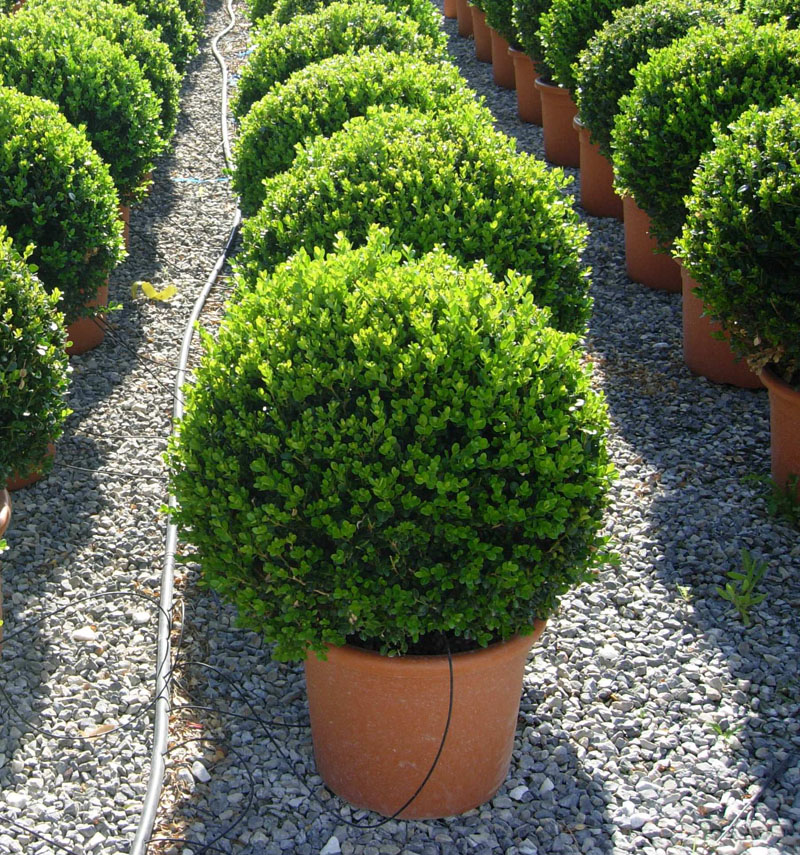
There are about 30 types of boxwood, each of which has its own uniqueness. Most often, for planting as a hedge, an evergreen or ordinary variant is used.
| Transfer | The plant is planted at the age of 3 years. There are no exact restrictions on the time of year, it is possible to plant from spring to autumn, and it is better to plant younger shoots in late autumn. It is better to plant on a cloudy day by digging a small hole, slightly larger than the size of the root system. |
| The soil | Not whimsical in the choice of soil, but a layer of compost of 10-15 cm should be laid on the bottom of the trench. |
| reproduction | Only with the help of cuttings that are planted in. About 80% of shrubs take root well in loose soil. It is better to cover new shoots with a film or a jar first. |
| Care | The plant tolerates frosts not higher than 20 ⁰, otherwise it should be wrapped or covered with burlap, and the horse system should be protected with a layer of fallen leaves. |
Important! Do not cover boxwood with polyethylene: this leads to an excess of moisture and the plant dies.
Boxwood shrub options for decor or creating a hedge:
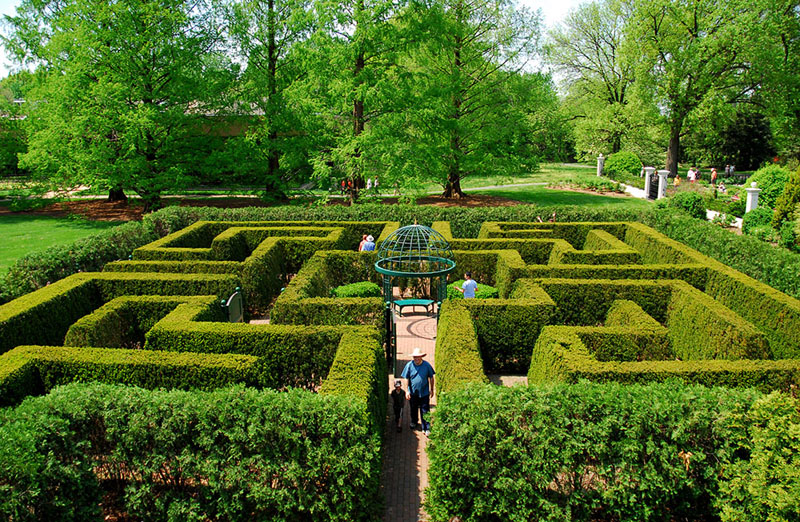
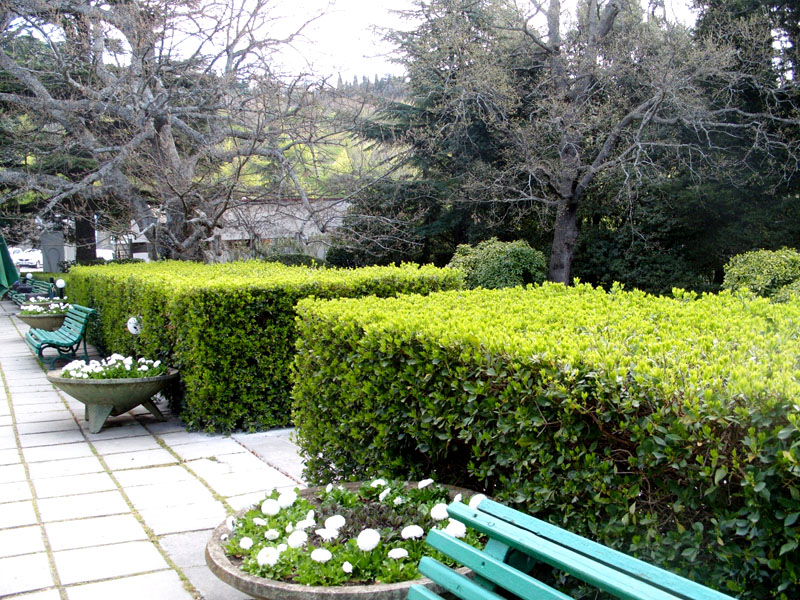

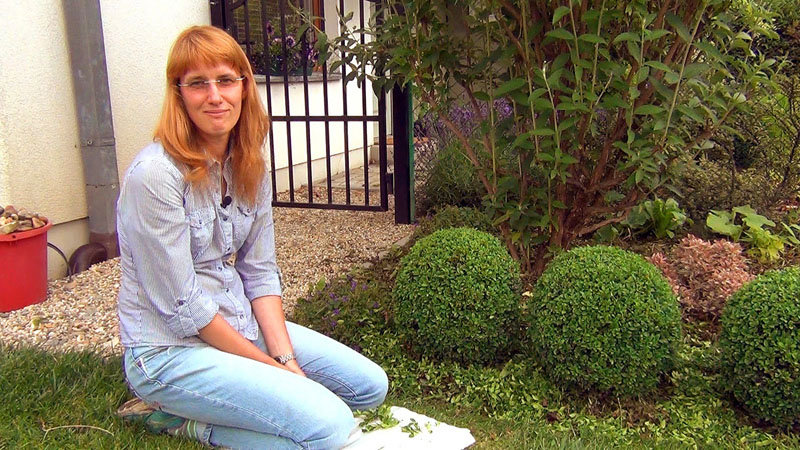
Thuja hedge
Thuja is an evergreen plant that lends itself well to shearing and does not require special care. Most often, two variants of the tree are planted: Brabant and emerald.
Thuja Brabant: description, photo
Below is a photo of thuja Brabant, planting and caring for which is not a lot of trouble. This evergreen plant withstands frosts down to -30⁰. The average height is 20 m, and in a year the tree grows by 30 - 80 cm. It is propagated by cuttings or seeds.
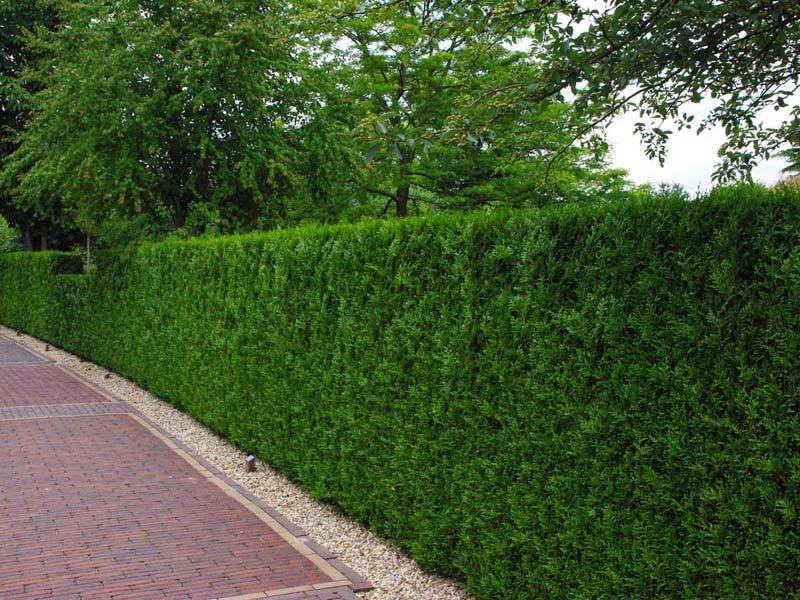
When choosing a landing site, keep in mind that thuja loves light and warmth. The brightness of the color depends on the sun's rays. But you can not allow the plant to overheat. Therefore, find a place of penumbra. It is worth planting seedlings at a distance of half a meter, since the tree has a wide crown.
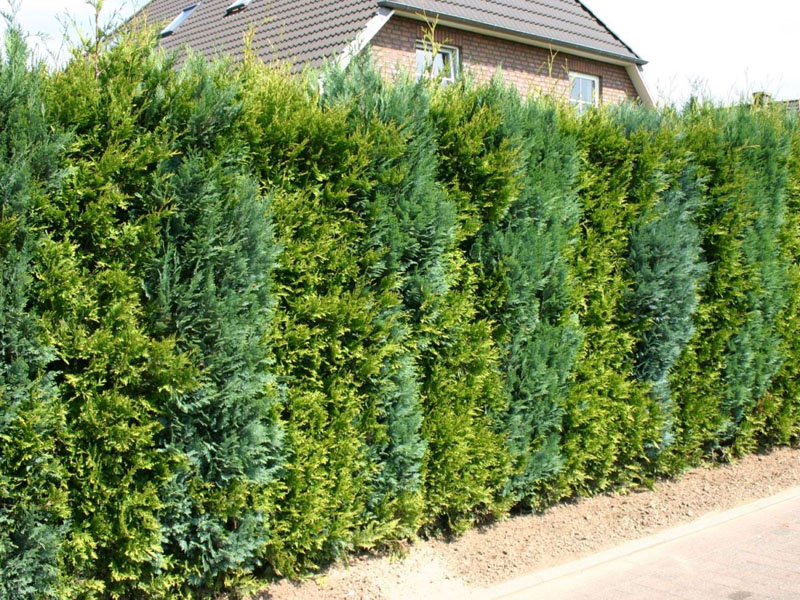
Fertilize the soil at the time of planting. In the first year, 3 more times with an interval of 4 months. Then, you can reduce to 1 time - in the spring.
Thuja smaragd: planting and care
The choice of thuja for hedges is not accidental. A unique and unpretentious plant that can be cut several times a year and planted in partial shade. The variety of coniferous thuja smaragd has a pointed shape and needles that are tightly adjacent to each other.

The color always remains emerald green, even in severe frosts. Not whimsical to the soil, but a layer of drainage should be made in the pit. He loves partial shade and does without additional fertilizers and watering.
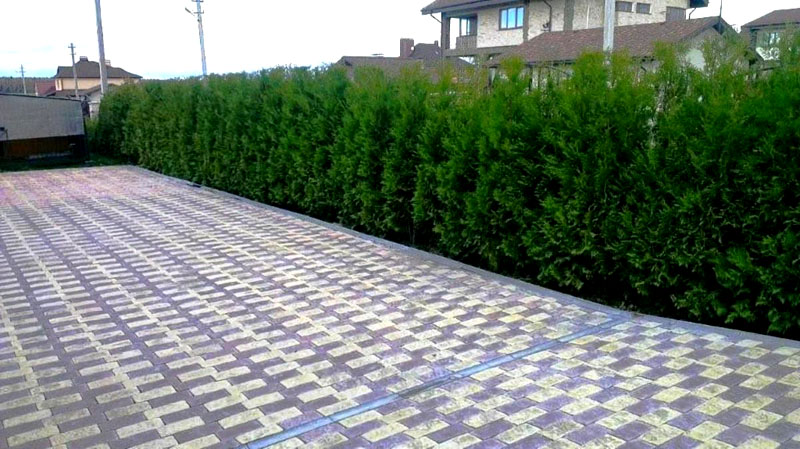
Planted by seedlings, an adult plant grows up to 5 m in height. Perfect for creating a green "fence".
Article



